#Observer Big Idea Ethical Award
Explore tagged Tumblr posts
Text
*Ethos, Pathos, Logos*
youtube
In this entry, I will examine the critical question(s): What is the main purpose of this artifact's message and how are ethos, pathos, and logos used in this rhetorical artifact to achieve that purpose? Is the way that these rhetorical appeals are used ethically?
To investigate these questions, I examined the acceptance speech by Camila Cabello after she received the “Breakthrough Artist of the Year” at the Billboard Women in Music 2017 as my rhetorical artifact. Camila Cabello uses ethos, pathos, and logos to honor women, specifically her mother, for her contributions to her children’s successful career and life. Overall, this is an ethical speech because she shares the credit by effectively underscoring the profound impact women, especially mothers, have in shaping the lives or success of their children.
Camila Cabello is a famous American singer and songwriter. After she left Fifth Harmony - one of the most famous girl groups in the world, she debuted in 2017 with a solo album and followed with her best single “Havana”, inspired by the name of the largest city in Cuba, where she was born. The single helped her achieve many rewards and be at the top of many record charts around the world and “Breakthrough Artist of the Year” at Billboard Women in Music 2017 was one of them. In her acceptance speech, she expressed a moment of celebration and acknowledgment of her mother’s contribution to her solo success. She highlights her mother as an immigrant from Cuba, arriving with little more than the clothes on her back. She emphasizes the resilience, courage, and perseverance of her mom that enabled her to overcome obstacles. Camila Cabello conveys that, although she stands on the stage, her mother's influence and example are the driving forces behind her success. She praises her mother's qualities with many roles such as a protector, confidant, healer, and best friend. The speech underscores the deep love and appreciation Cabello has for her mother and the importance of recognizing the powerful role that women, especially mothers, play in their children’s lives.
Aristotle, the ancient Greek philosopher, introduced the concepts of ethos, pathos, and logos as fundamental elements of persuasive communication in his work on rhetoric. These concepts are essential to understanding how effective arguments and persuasive messages are constructed. James A. Herrick discusses how Aristotle conceptualized rhetoric as the art of persuasion and argumentation. He observes Aristotle’s idea of rhetoric and calls these modes of persuasion “three artistic proofs” (Herrick 78), and their significance in effective communication. He explains these concepts are “logos or arguments and logical reasoning, pathos or the names and causes of various emotions, and ethos or human character and goodness” (78). Logos is the logical or rational appeal of an argument. It is based on using evidence, reasoning, facts, and structured arguments to support a claim or persuade an audience. Logos appeals to the audience's intellect and their capacity for logical thinking, which separates us from natural animals based on Aristotle. Pathos is the use of emotional language, storytelling, and vivid imagery to evoke feelings, empathy, and passion in the audience. Pathos is employed to connect with the audience's emotions, making them more receptive to the message and influencing their decisions and actions. Ethos refers to the ethical or moral character of a speaker or author. It is an appeal to the audience's perception of the speaker's credibility, trustworthiness, and expertise. In persuasive communication, ethos involves establishing the speaker's or writer's authority on the subject matter, demonstrating honesty and integrity, and fostering trust.
First of all, Camila Cabello uses ethos appeal to appear as a pious and humble woman by dedicating a big reward to her mother and showing how important her mother is in her life. After receiving the award, she stated “I'd just like to say the only reason I'm standing here on this stage, in this auditorium, and on this soil, in this country, is because of one woman, and that's my mom. Tonight, we're celebrating women of this year, and I want to take this opportunity to say thank you to the woman of my life” (0:16). By using the phrase “the only reason,” Cabello immediately underscores the central role her mother played in her success. She already proved that she has talent by receiving this award but her whole speech was about her mom. This phrase emphasizes her humility and gratitude while positioning her mother as the key figure in her life. In addition, by referring to the event as a celebration of women, Cabello aligns her gratitude with the theme of the awards ceremony. She emphasizes her mother's significance as a representative of all women to connect her personal message to the broader context of honoring women's contributions to support their children’s achievements.
Secondly, Cabello uses a narrative about her mother coming to a new country with her desire to provide a better future for Cabello as a pathos appeal to encourage her audience to feel inspired to overcome obstacles and work toward a better future. She says with a shaking voice “She came to this country from Cuba with nothing but her clothes on her back for me. Breaking through doubt, breaking through fear, literally breaking through barriers. and when I hear the word perseverance when I hear the word love it has a face and it's hers” (0:40). Cabello highlights her mother's courage and selflessness by noting that she arrived in a new country with very little, symbolized by “nothing but her clothes on her back.” This emphasizes the immense sacrifice her mother made to provide her with a better life. Her mother decided to overcome the difficulties in a new country to secure a better future and obviously helped Camilla Cabello become a successful and kind artist. This description of the journey evokes inspiration, touch, and pride from her audience for what she's achieved and what her mom has sacrificed for her. These emotions suggest a powerful motivation that doubts or fears should not hold one back and they should break through all the challenges and take risks to pursue their aspirations. Again, she connects the award she just received “Breakthrough Artist” with the repeated term “breaking through” to remind her audience that the theme of the award is honoring women, especially all the mothers who have done everything just to bring a better future for their kids
Finally, Camila Cabello uses logos appeal with a logical structure of evidence and argument to highlight her mother's guidance and support as a model of good parenting, ultimately honoring women as influential figures for the success of their children. She states “She tells me the only way to live life is to live it intensely and she showed me whenever you are the most afraid that's when you got to make the jump. So you might see me up here on the stage tonight, but behind me backstage, looking at me right now, hi, Mama, I have the most incredible example of what it means to be a woman. An unstoppable storm, a healer of heartbreak, a protector, a confidant, a therapist, a psychic, and my best friend” (0:57). Cabello begins by sharing the life lessons and wisdom her mother has imparted, such as “the only way to live life is to live it intensely” and the advice to “make the jump” when you are most afraid. She values her mother’s guidance and applies it in her life to grow up and gain achievements as the public perceives. Her words not only celebrate her own mother but also serve as a broader tribute to women in the role of mothers. She goes on to enumerate the various roles her mother plays in her life, using phrases like “an unstoppable storm, a healer of heartbreak, a protector, a confidant, a therapist, a psychic, and my best friend.” This enumeration serves as evidence of why Cabello really believes in her mother's advice. It logically supports the claim that her mother embodies the qualities of a good parent. The statement she makes when she claims that all the things her mother has done are “the most incredible example of what it means to be a woman” reinforces the idea that her mother has had a positive effect on her life and has had a major influence on her development as a successful artist or daughter. It also serves to empower women that they are powerful, supportive, and multi-talented.
In general, this is an ethical speech as the speaker underscores the importance of recognizing and appreciating women's roles, which is also suitable for the theme of the scene she’s standing to speak: Women. Throughout her address, Cabello expresses deep gratitude and admiration for her mother and, by extension, for all women and mothers. She acknowledges the pivotal role women play in the lives and successes of their children, emphasizing their contributions. Besides that, she not only attributes her success to her mother but also extends this recognition to all women. This sharing of credit demonstrates humility and acknowledges that individual achievements are often intertwined with the support and sacrifices of others, particularly mothers.
In conclusion, Camila Cabello's acceptance speech at the 2017 Billboard Women in Music awards is a moment of women recognition and empowerment. The speakers effectively use Aristotle's concept of a persuasive speech with ethos, pathos and logos to achieve her message's purpose. Cabello appears on the stage as a humble artist through ethos, shares personal story about her mother, the only person qualified to be a woman in her life, to inspire audiences to face challenges and break through barriers to pursue their goals, and connects her love to her mother to the appreciation of all the women in the world. Her main purpose is to highlight the importance of good parenting and women’s role, especially mothers, in raising children, shaping the right direction to success for their children.
Works Cited
Herrick, James A. “Aristotle on Rhetoric.” The History and Theory of Rhetoric, 2013, pp. 69–81, https://doi.org/10.4324/9781315664019-10.
YouTube, 1 Dec. 2017, https://youtu.be/C7LN_szqUmc?si=GX_-IEYcoR2tzD-1. Accessed 27 Oct. 2023.
0 notes
Text
𝕽𝖊𝖇𝖊𝖑𝖑𝖎𝖔𝖓

Most would say its easy for a teenager to rebel at any point in time, but I find it hard to rebel in any way, most teens get tattoos, piercings, cut and dye their hair to rebel against their parents, but growing up with a mom who is tattooed, hair in fun dyed styles and piercings, I’m really just following in her footsteps she practically encourages.
The only thing I rebel against is tidying my room and making cups of tea, cant really say I could start a world changing rebellion on that.
Rebellions i find important
1903–18 — Women’s Suffrage Movement The foundation of the Women’s Social and Political Union by Emmeline Pankhurst in 1903 began a more militant phase of the call for votes for women, which had been growing through the end of the 19th century. The Suffragettes used militant tactics like vandalism, arson, bombing and hunger strikes, with one member committing public suicide by throwing herself under the King’s horse at a race in 1913. The movement was wound up when some women were enfranchised in the 1918 Representation of the People Act, before all women over 21 were given the vote in 1928.
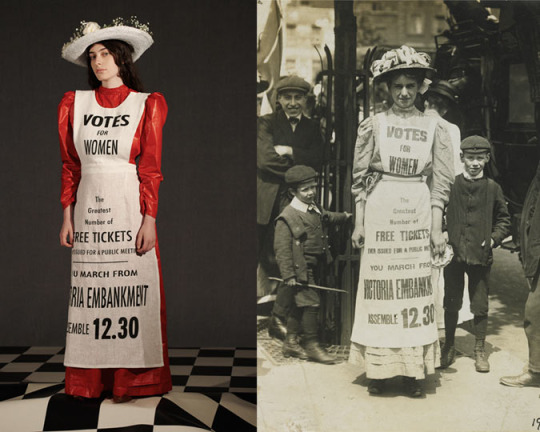
Suffragette Vera Wentworth in 1909, and the dress by Vaquera that it inspired

Stonewall riots 28 Jun 1969 – 3 Jul 1969 The Stonewall riots were a series of spontaneous demonstrations by members of the gay community in response to a police raid that began in the early morning hours of June 28, 1969, at the Stonewall Inn in the Greenwich Village neighborhood of Manhattan, New York City.
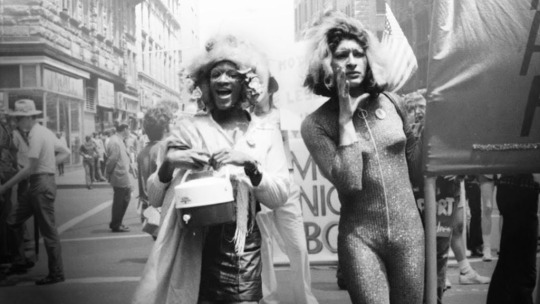
It is said that Marsha P. Johnson was the one who started the rebellion. Supposedly, throughout the bustle of the raid, Marsha threw a shot glass into a mirror and shouted, ” I got my civil rights!”. With this inspiration and resistance against the police, other patrons began to follow.
Present day- Me Too movement.The Me Too movement, with variations of related local or international names, is a social movement against sexual abuse and sexual harassment towards women, where people publicize allegations of sex crimes.


The Punk Rebellion
the punk involved no protests or riots, it impacted people, fashion, music, society and everything to be honest.

The punk subculture advocates a do-it-yourself (DIY) ethic. During the subculture's infancy members were almost all from a lower economic class, and had become tired of the affluence that was associated with popular rock music at the time. Punks would publish their own music or sign with small independent labels, in hopes to combat what they saw as a money hungry music industry. The DIY ethic is still popular with punks.ideology's of punks
Ideology
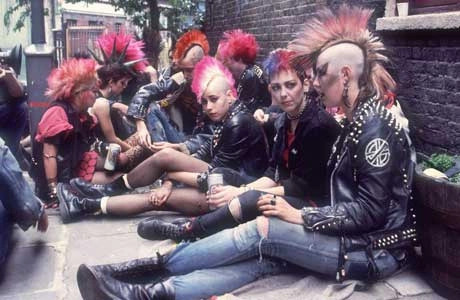
Punk political ideologies are mostly concerned with individual freedom and anti-establishment views. Common punk viewpoints include individual liberty, anti-authoritarianism, a DIY ethic, non-conformity, anti-collectivism, anti-corporatism, anti-government, direct action and not "selling out".
Some groups and individuals that self-identify as being a part of punk subculture hold right-wing views. The belief that such views are opposed to the original ethos of the punk subculture, and its history, has led to internal conflicts and an active push against such views being considered part of punk subculture at all. Two examples of this are an incident during the 2016 American Music Awards, where the band Green Day chanted anti-conservative, anti-racist, and anti-fascist messages, and an incident at a show by the Dropkick Murphys, when bassist and singer Ken Casey, tackled an individual for giving a nazi-style salute and later stated that nazis are not welcome at a Dropkick Murphys show. Band member Tim Brennan later reaffirmed this sentiment. The song "Nazi Punks Fuck Off" by hardcore punk band Dead Kennedys has come to be considered an anti-nazi anthem.
VIV WESTWOOD
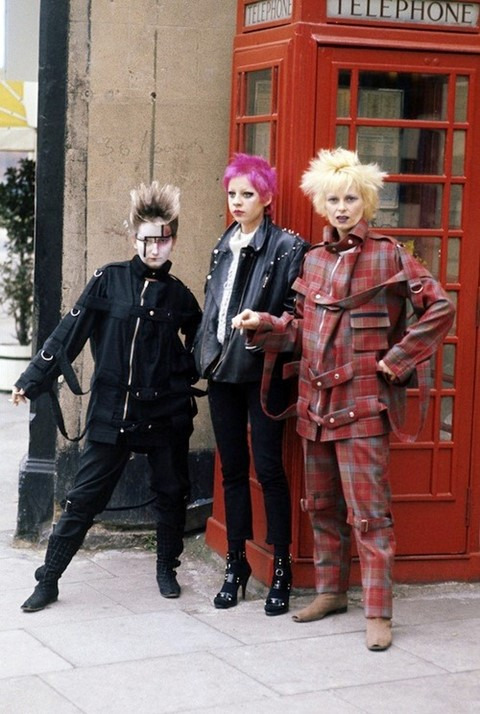
Rejecting the hippie ethos that was fashionable towards the end of the 1960s, Westwood and McLaren created clothes that referenced youth culture's recent past, selling rock'n'roll fashion in a shop unit at 430 King's Road in Chelsea. In 1974, the shop took on its most notorious identity: SEX, with Westwood and McLaren designing fetish wear that they sold to prostitutes, those with 'underground' sexual tastes, and young proto-punks brave enough to take a seriously edgy look out onto the street. The pair enjoyed shocking people, designing garments and shoes that referenced 'deviant' sexual practices, including rubber dresses and stilettos bristling with spikes.

How punk influenced me, because it influenced the world
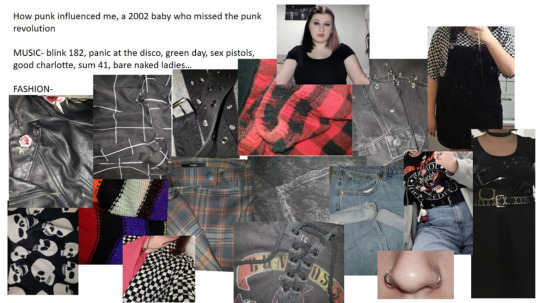
My take on rebellion
Westwood inspired tights.



after watching a documentary on vivien westwood and the birth of the punk revolution i created some westwood inspired tights as a little spontaneous brainstorm, did not develop any further on the tights.
i used a pair of brand new white tights and put holes all in them, this is non conformist as if a regular pair of tights had a hole you would bin them as they were no good any more, but purposely putting holes in is quite rebellious in that aspect, i used sharpies to draw triggering symbols and words such as a swastikka and ���punk fag’ .
crayon drawings
i used crayons to create these images as i thought it was a more rebellious medium and its created for kids so that is non conforming and it gives a rough diy finish look making it look slightly unfinished

i created a lesbian nun, this was a spur of the mind thought whats socially good and respected? a nun? whats the opposite of what a nun preaches, homo behavior.

here i did a little barbie series drawing from observational on one and on another from mind and another from an image which i created by burning a barbie ehich is quite a rebellious act in a way.




Collages
i decided to do some collages as its a way of just slapping ideas out in a visual format, my first one was using a fashion magazine and i realized this was the way to go so i printed some punk imagery and even used my own crayon drawings to create more collages.

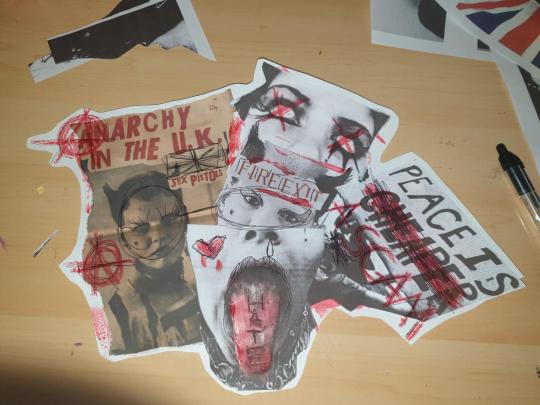

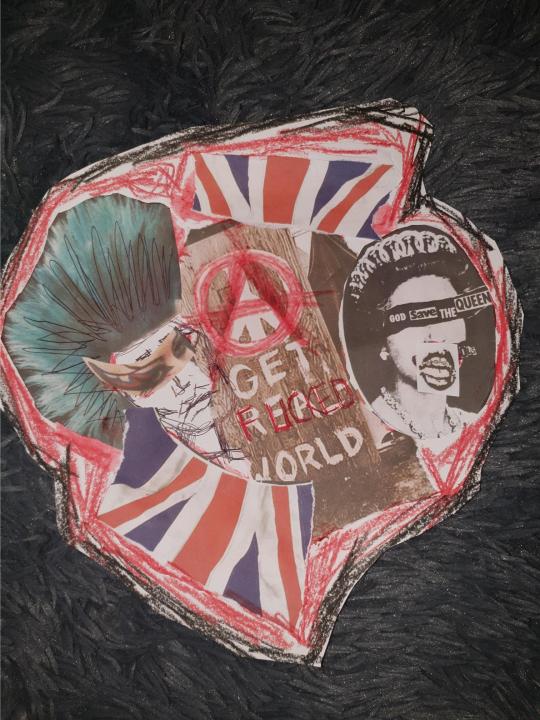
photo shop
i wanted to mess with these collages more on a digital format so i put them in to photo shop to play with them and generate more ideas this was giving me a poster vibe which reminded me of punk posters.
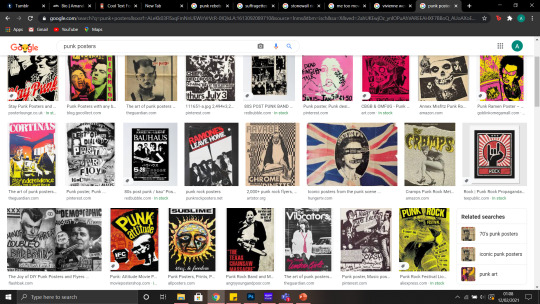
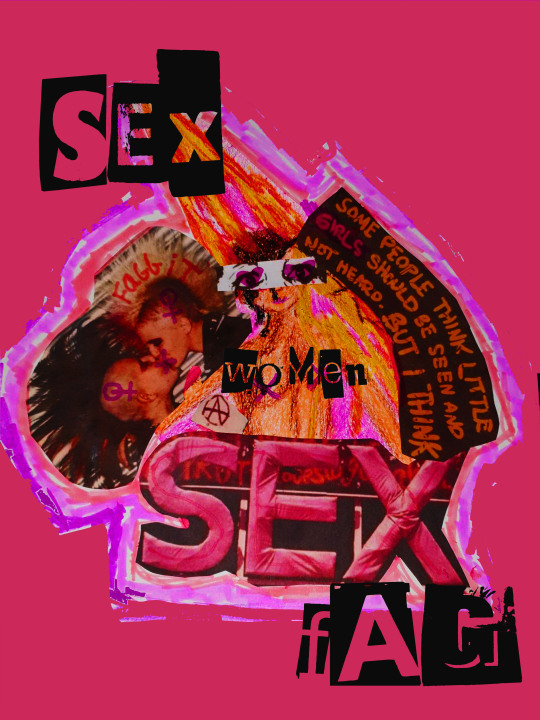
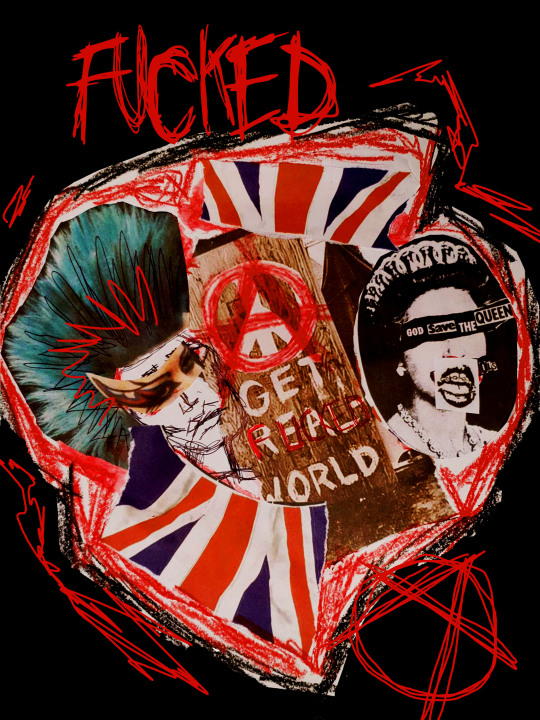

Final ideas
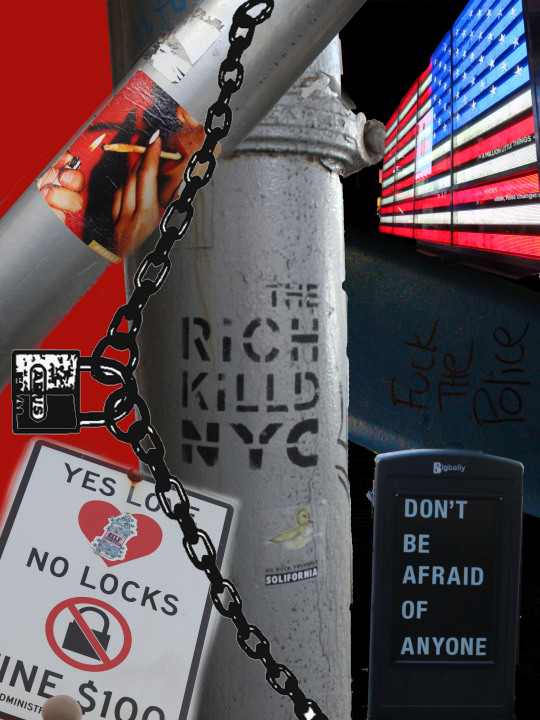
i used images from the new york trip to create a vision on photo shop, using a light of the american flag,sign posts, bins with posters on them.a clip art image of a chain and lock,street art and stickers i saw on poles in the street which is another form or street art which is quite rebellious as its not socially acceptable to vandalize and graffiti on public areas.

i took a few elements from the last board and included them in this vision board, i really wanted the main focus to be on the pipe that says “the rich killed nyc” i feel like it has a deep meaning behind it and it is quite rebellious as it reminded me of the punk rebellion in the uk as it was mostly lower class working people who used art, music and fashion to rebel against society and social constructs and actively non conform to the “rules” in a way. i also used a sticker that says jesus loves you and i crossed it out and wrote hate you over the loves you part as that is fitting to my rebellious visions.

in this board i again used “ the rich killed nyc” pipe as that’s my main surrounding element, i uses another pole with stickers on though you cant really tell what the stickers are, it just fits the aesthetic. i used a statue of liberty as she is known as a symbol of freedom, and along side it i used a photo of a photograph i saw in the modern art museum where this person had dyke tattooed on their neck which is a derogatory word to gay women, and that’s quite rebellious to take a bad word and own it by tattooing it on your body .
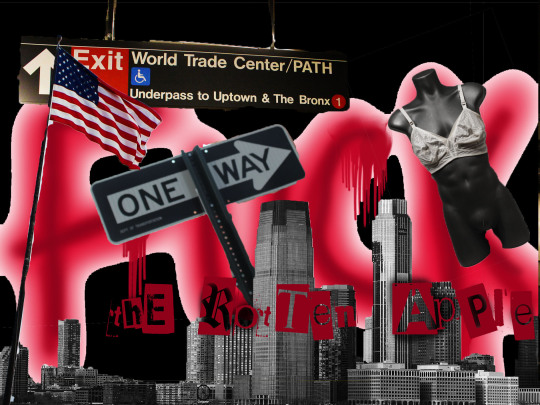
in this board i moved away from “the rich killed nyc” pipe as i felt i needed to come away from that one element for one board and to broaden my ideas. in this one i used a sky line image i took when on the ferry to liberty island, i changed the colour to black and white as the original colours of the image are quite blue and orangy, i used a sign post that says one way as it for some reason reminded me of like “one way to hell” or something and that there feels like there is no choice or individuality in the phrase “one way” . i used text over the sky line that says “the rotten apple” as new york city is known as the big apple and i thought, when i was there it did not remind me of a big fresh beautiful apple as the homeless people on the streets and the graffiti that has no artistic intent, so it was more of a rotten apple in a way. i used an image of the american flag i took on liberty island as i used an image of an american flag light, so i thought i could link back to that idea and use an actual flag, as its to represent freedom. i also used a art piece from the modern art gallery which was just a male mannequin wearing a bra which does not fit the social constrict of what men should wear there for its quite rebellious and opposite to the one way system.

in my final board i included the american flag, a chain over it completely doing the opposite of what the flag means which is freedom, i used the bun that says don’t be afraid of anyone with an edited red paint drip on it which kind of looks like blood, i used text that says “ the rich killed nyc” as i loved that phrase bit i over used the pole in the other boards and i liked that my main message is that the rich killed nyc, i used an image of my dr martens that i took while my feet were up against a pole as i sat on a tube, showing anti social behavior basically which is stereo typically rebellious,and also dr martens were quite fashionable in the uk punk rebellion so i’m hinting to my idea that was inspired by the uk punk rebellion, and finally i have a set of traffic lights which are about order and control, the light is also on red which signifies danger, and the word stop which fits to my idea.
11 notes
·
View notes
Text
The Conscience of Words
“We fret about words, we writers. Words mean. Words point. They are arrows. Arrows stuck in the rough hide of reality. And the more portentous, more general the word, the more they also resemble rooms or tunnels. They can expand, or cave in. They can come to be filled with a bad smell. They will often remind us of other rooms, where we’d rather dwell or where we think we are already living. They can be spaces we lose the art or the wisdom of inhabiting. And eventually those volumes of mental intention we no longer know how to inhabit will be abandoned, boarded up, and closed down.
What do we mean, for example, by the word “peace”? Do we mean an absence of strife? Do we mean a forgetting? Do we mean forgiveness? Or do we mean a great weariness, an exhaustion, an emptying out of rancour? It seems to me that what most people mean by “peace” is victory. The victory of their side. That’s what “peace” means to them, while to the other’s peace means defeat. If the idea takes hold that peace, while in principle to be desired, entails an unacceptable renunciation of legitimate claims, then the most plausible course will be the practice of war by less than total means. Calls for peace will be felt to be, if not fraudulent, then certainly premature. Peace becomes a space people no longer know how to inhabit. Peace has to be re-settled. Re-colonised.
And what do we mean by “honour”? Honour as an exacting standard of private conduct seems to belong to some faraway time. But the custom of conferring honours—to flatter ourselves and one another—continues unabated. To confer an honour is to affirm a standard believed to be held in common. To accept an honour is to believe, for a moment, that one has deserved it. (The most one should say, in all decency, is that one is not unworthy of it.) To refuse an honour offered seems boorish, convivial, and pretentious. A prize accumulates honour—and the ability to confer honour—by the choice it has made in previous years of whom to honour.
By this standard, consider the polemically named Jerusalem Prize, which, in its relatively short history, has been awarded to some of the best writers of the second half of the twentieth century. Though by any obvious criteria a literary prize, it is not called The Jerusalem Prize for Literature but The Jerusalem Prize for the Freedom of the Individual in Society. Have all the writers who have won the prize really championed the Freedom of the Individual in Society? Is that what they—now I must say “we”—have in common? I think not.
Not only do they represent a large spectrum of political opinion. Some of them have barely touched the Big Words: freedom, individual, society. But it isn’t what a writer says that matters, it’s what a writer is. Writers—by which I mean members of the community of literature—are emblems of the persistence (and the necessity) of individual vision.
I prefer to use “individual” as an adjective rather than as a noun. The unceasing propaganda in our time for “the individual” seems to me deeply suspect, as “individuality” itself becomes more and more a synonym for selfishness. A capitalist society comes to have a vested interest in praising “individuality” and “freedom”—which may mean little more than the right to the perpetual aggrandisement of the self, and the freedom to shop, to acquire, to use up, to consume, to render obsolete.
I don’t believe there is any inherent value in the cultivation of the self. And I think there is no culture (using the term normatively) without a standard of altruism, of regard for others. I do believe there is an inherent value in extending our sense of what a human life can be. If literature has engaged me as a project, first as a reader and then as a writer, it is as an extension of my sympathies to other selves, other domains, other dreams, other words, other territories of concern. As a writer, a maker of literature, I am both a narrator and a ruminator. Ideas move me. But novels are made not of ideas but of forms. Forms of language. Forms of expressiveness. I don’t have a story in my head until I have the form. (As Vladimir Nabokov said: “The pattern of the thing precedes the thing.”) And—implicitly or tacitly—novels are made out of the writer’s sense of what literature is or can be. Every writer’s work, every literary performance is, or amounts to, an account of literature itself. The defense of literature has become one of the writer’s main subjects. But as Oscar Wilde observed, “A truth in art is that whose contradictory is also true.” Paraphrasing Wilde, I would say: A truth about literature is that whose opposite is also true. Thus, literature—and I speak prescriptively, not just descriptively—is self-consciousness, doubt, scruple, fastidiousness. It is also—again, prescriptively as well as descriptively—song, spontaneity, celebration, bliss. Ideas about literature—unlike ideas about, say, love—almost never arise except in response to other people’s ideas. They are reactive ideas.
I say this because it’s my impression that you—or most people—are saying that. Thereby I want to make room for a larger passion or different practice. Ideas give permission—and I want to give permission to a different feeling or practice. I say this when you’re saying that, not just because writers are, sometimes, professional adversaries. Not just to redress the inevitable imbalance or one-sidedness of any practice which has the character of an institution—and literature is an institution—but because literature is a practice which is rooted in inherently contradictory aspirations.
My view is that any one account of literature is untrue that is, reductive; merely polemical. While to speak truthfully about literature is necessarily to speak in paradoxes. Thus, each work of literature that matters, that deserves the name of literature, incarnates an ideal of singularity, of the singular voice. But literature, which is an accumulation, incarnates an ideal of plurality, of multiplicity, of promiscuity. Every notion of literature we can think of—literature as social engagement, literature as the pursuit of private spiritual intensities, national literature, world literature—is, or can become, a form of spiritual complacency, or vanity, or self-congratulation.
Literature is a system—a plural system—of standards, ambitions, and loyalties. Part of the ethical function of literature is the lesson of the value of diversity. Of course, literature must operate within boundaries. (Like all human activities. The only boundless activity is being dead.) The problem is that the boundaries most people want to draw would choke off the freedom of literature to be what it can be, in all its inventiveness and capacity to be agitated. We live in a culture committed to unifying greed, and one of the world’s vast and glorious multiplicity of languages, the one in which I speak and write, is now the dominant language. English has come to play, on a world scale and for vastly larger populations within the world’s countries, a role similar to that played in medieval Europe by Latin.
But as we live in an increasingly global, transnational culture, we are also mired in increasingly fractionalised claims by real or newly self-constituted tribes. The old humanistic ideas—of the republic of letters, of world literature—are under attack everywhere. They seem, to some, naive, as well as tainted by their origin in the great European ideal—some would say Eurocentric ideal—of universal values. The notions of “liberty” and of “rights” have undergone a striking degradation in recent years. In many communities, group rights are given greater weight than individual rights. In this respect, what makers of literature do can, implicitly, bolster the credibility of free expression, and of individual rights. Even when makers of literature have consecrated their work to the service of the tribes or communities to which they belong, their accomplishment as writers depends on transcending this aim.
The qualities that make a given writer valuable or admirable can all be located within the singularity of the writer’s voice. But this singularity, which is cultivated in private and is the result of a long apprenticeship in reflection and in solitude, is constantly being tested by the social role writers feel called on to play.
I do not question the right of the writer to engage in debate on public matters, to make common cause and practice solidarity with like-minded others. Nor is my point that such activity takes the writer far from the reclusive, eccentric inner place where literature is made. So do almost all the other activities that make up having a life. But it’s one thing to volunteer, stirred by the imperatives of conscience or of interest, to engage in public debate and public action. It’s another to produce opinions—moralistic sound-bites on demand.
Not: Been there, done that. But: For this, against that. But a writer ought not to be an opinion-machine. As a black poet in my country put it, when reproached by some fellow African-Americans for not writing poems about the indignities of racism, “A writer is not a jukebox.” The writer’s first job is not to have opinions but to tell the truth and refuse to be an accomplice of lies and misinformation. Literature is the house of nuance and contrariness against the voices of simplification. The job of the writer is to make it harder to believe the mental despoilers. The job of the writer is to make us see the world as it is, full of many different claims and parts and experiences. It is the job of the writer to depict the realities: the foul realities, the realities of rapture. It is the essence of the wisdom furnished by literature (the plurality of literary achievement) to help us to understand that, whatever is happening, something else is always going on.
I am haunted by that “something else.” I am haunted by the conflict of rights and of values I cherish. For instance that—sometimes—telling the truth does not further justice. That—sometimes—the furthering of justice may entail suppressing a good part of the truth. Many of the twentieth century’s most notable writers, in their activity as public voices, were accomplices in the suppression of truth to further what they understood to be (what were, in many cases) just causes.
My own view is, if I have to choose between truth and justice—of course, I don’t want to choose—I choose truth.”
-Susan Sontag, At the Same Time: Essays and Speeches-
#quote#women writers#love#life#art#meaning#on writing#all#all eternal things#love in a time of...#intelligence quotients#depth perception#creative power#literary sensibilities#truth be told#language matters#underneath it all#more than words#stands on its own#elisa english#elisaenglish
4 notes
·
View notes
Text
Documenting 2: Visual Research
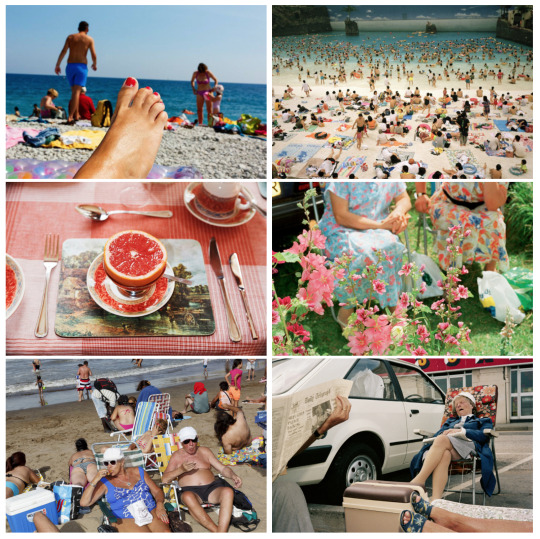
Martin Parr
Martin Parr is an English documentary photographer who is best known for his photography of the tradition of the Great British Holiday. He is probably my favourite photographer in the world, as I love how honestly and candidly he captures life. He has had around 40 solo photobooks published, and has featured in around 80 exhibitions worldwide. When asked about the art of documenting people through photography, and the ethics involved, he said the following:
“I think that all photography involving people has an element of exploitation, and therefore I am no exception. However it would be a very sad world if photographers were not allowed to photograph in public places. I often think of what I photograph as a soap opera where I am waiting for the right cast to fall into place. In more recent years I have photographed much closer where bits of people and food become part of the big picture, and one advantage of this is that it means people are less recognisable.”
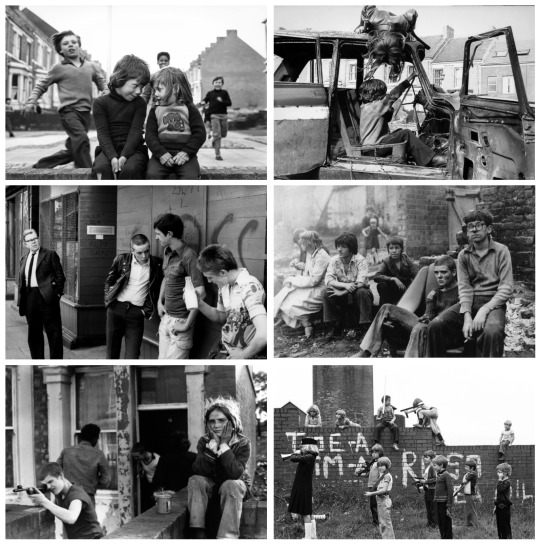
Tish Murtha
Tish Murtha was a Northern English documentary photographer who took black and white photos to create a record of youth unemployment, juvenile jazz bands, kids in Elswick in South Shields, and a series of photos of London by night. Her work is very striking and raw, the black and white photography really adds a sort of grit and solemness to her photographs.
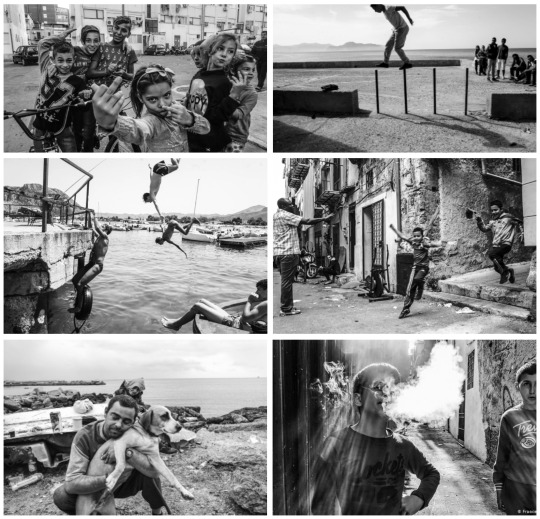
Francesco Faraci
Faraci is a Sicillian street photographer. I think his work is really beautiful and raw, and much like a contemporary version of Tish Murtha’s work.
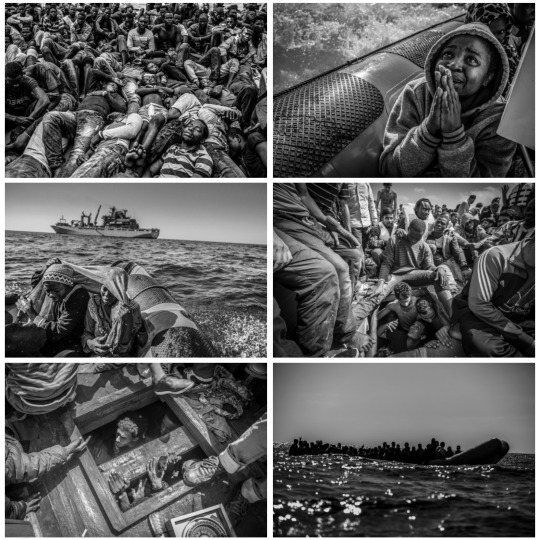
Jason Florio
Jason Florio is an English documentary photographer. This photoseries is called Destination Europe, and it shows the journey of refugees from Libya to Europe. He has done several documentation projects all around the world, and Destination Europe was one that won him a Magnum Photography Award in 2017. These photos are seriously effecting - they are beautiful and devastating, and tell a story brilliantly. This is documentary photography with a real purpose and meaning. These photos are heartbreaking.
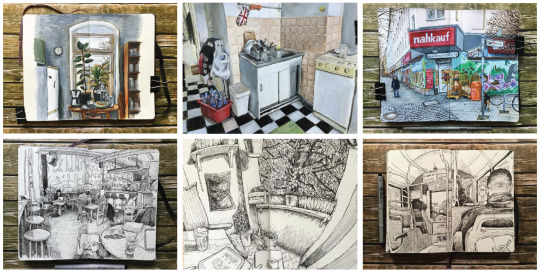
Keir Edmonds
“Berlin-based English urban sketching artist Keir Edmonds keeps a visual diary that illustrates his life as an expat in Germany’s capital. Believing that “you have to put in 10,000 hours to get really good at something,” the self-confessed “Englishman lost in Berlin” carries a sketchbook and pen everywhere he goes. From local architecture to summertime canals and graffiti-covered streets, his growing portfolio captures the undeniable charm of the city.
Edmonds started keeping sketchbook journals in 2015 with the goal to improve his skills in observational drawing.”
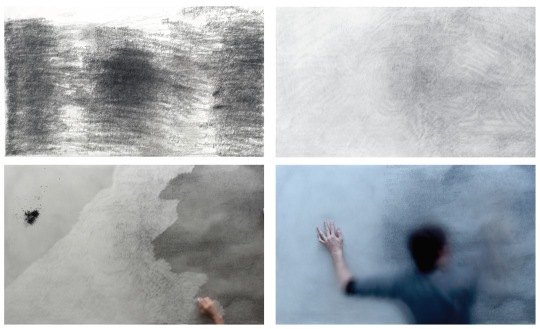
Sam Winston
Sam Winston is an artist based in London, who says his “practice is concerned with language not only as a carrier of messages but also as a visual form in and of itself”. He is known for his typography and his abstract illustration, having worked with some of the biggest art galleries in the world.
These images are from a project he undertook called 7 days - “a long durational studio work where the artist lived without sight for seven days and nights. Repeatedly transcribing five sentences the image created is without any visual reference.”
Sam says, “The idea of going ‘under’ or without images fascinated me. I had read of yogis spending years in complete darkness and psychologists running light deprivation studies but for me the question was - what landscapes are available to the artist when they are only given an internal view for seven days?
Biologically speaking the absence of daylight triggers large hormone imbalances in the pineal glad located in the centre of the brain. This gland normally releases melatonin which is the hormone that regulates sleep - and with this out of balance - you will quickly find yourself operating outside of conventional time.”
This method of abstract documentation is something I find very intriguing. As a designer, you have information input into you and it is your job to translate this meaningfully into the world. If we restrict our outputs and inputs, and put ourselves under strictor creative parameters, then as creatives we we surely find a way to make great work through the power of thinking ourelves out of those restrictions.
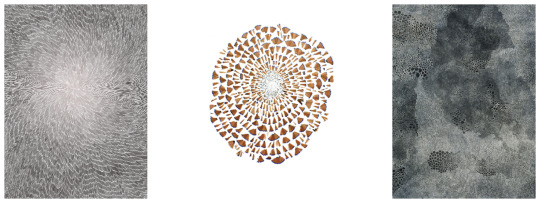
1. ‘A durational work where a pencil line records the length of every exhalation. The length of each line marks the length of time it takes to exhale. These marks were recorded over a 15 hour day without break. “The premise is deceptively simple - marking either an exhalation or inhalation with a pencil line - the length of the duration of a breath. Yet the cumulative effect of this action is a map that reveals a unique bridge between our unconscious and conscious functioning. It is also a refocusing of attention to our dependent relationship within the aerobic world.”
2. ‘An on going series of collages looking a various components of drawing. Each image contains one complete pencil.“This is the beginnings of a process looking at the materiality of the objects that inform artistic practice. By literally exploding, dissolving and collaging broken down artists tools we reveal their history and legacy. Whether the pencil graphite is from mines in China or the New Mexican cotton farms that make rag made paper - each artwork is a testimony to a globalized economy and the unseen geography of the tools by which we make art. “‘
3. ‘Birth day is an project that charts the 183,600 lives that come into being on the planet over a period of 12 hours. The participants draw circles to remember loved ones and also register their names in writing. In this way the public are asked to connect their own personal narrative to the much broader theme of population growth and decline.“By the time you’ve read this sentence three people have been born into the world.From observing this process I have noticed that the moment a person draws a circle (and it has a name) the artwork stops being about statistics and becomes a wall of brothers, sisters, mothers etc - in this particular case representing 260,000 lives that are born and die in 12 hours.”’

The text of Shakespeare’s Romeo & Juliet was read and categorised into three emotional states – passion, rage & solace. Once theses these three categories of text were typeset & printed they became the material for three the hand cut collages. The final work is the combined print of the typeset category and the hand cut collage.
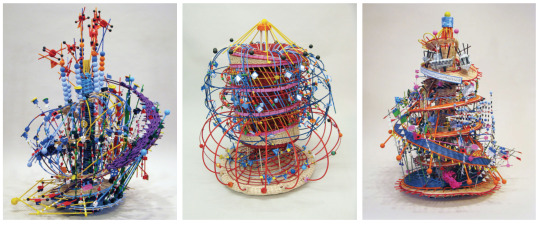
Nathalie Miebach
Boston-based conceptual artist Nathalie Miebach weaves colorful, complex sculptures using rope, wood, paper, fibers, and data from weather events. Two of the artist’s recent series explore the impact of storm waters on our lives and on marine ecosystems, with variables like wind and temperature (and the harmony of the composition) often informing the rainbow of colors used to translate the data into a three-dimensional structure.
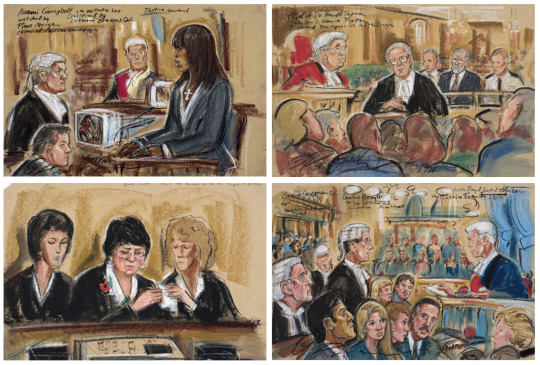
Priscilla Coleman
Priscilla Coleman is a courtroom illustrator. This is a dying art and in the UK there are only four official courtroom illustrators left. “It’s as if you’re memorising for a test,” she tells It’s Nice That. “You forget the details so you have to write something that will trigger your memory. Once I had to draw a line of airline hijackers, and they all had black hair but different hairstyles. One had long sideburns so I wrote Elvis, one was skinny so I wrote ‘skeleton man’, for others I wrote ‘potato nose’ or ‘fried hair’ or for another, I wrote the name of an ex-boyfriend he reminded me of! People’s faces are fascinating.”
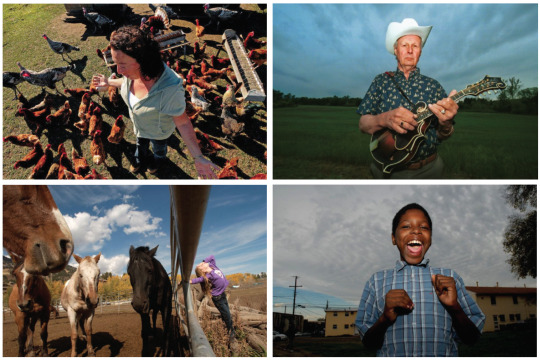

Scott Elmquist
This man is a very inspiring documentary photographer. The last image above is an extremely powerful photograph to me. It shows black youth playing basketball under the defaced statue of a coloniser. Amazing. Above that is part of his Americana documentary photography series, capturing rural midwestern America and it’s communities.
3 notes
·
View notes
Text
CBC NEWS The Royal Fascinator Feb. 7, 2020 Hello, royal watchers and all those intrigued by what’s going on inside the House of Windsor. This is your biweekly dose of royal news and analysis. Reading this online? Sign up here to get this delivered to your inbox. Janet Davison Janet Davison Royal Expert

Who will step up for Meghan and Harry?

(Lefteris Pitarakis/The Associated Press)
It was a striking image that day in June of 2012 — just six people on the balcony of Buckingham Palace, sending a signal widely interpreted to foreshadow a slimmed-down future for the House of Windsor.
It was the Queen’s Diamond Jubilee marking her 60 years as monarch, and joining her on the balcony were her eldest son and heir, Prince Charles; his wife, Camilla; Charles’s two sons, Princes William and Harry; and William’s wife, Kate. (The Queen’s husband, Prince Philip, was in hospital at the time and it would be four years before Harry met his wife, Meghan.)
Charles has long been thought to favour a core group of senior family members to carry the House of Windsor forward in the next reign.
But Harry and Meghan’s departure from the upper echelons of the family leaves a big hole in that plan.
"I think [Charles] envisaged having Harry as part of that,” Ingrid Seward, editor-in-chief of Majesty magazine, said via email.
Seward said that along with William and Kate, Charles saw his sister, Princess Anne, and his brother, Prince Edward, as part of the plan.
Harry’s departure “really blows a hole into Charles’s well-thought-out plan for a slimmed-down monarchy based on the core family,” royal biographer Sally Bedell Smith
told Vanity Fair
.
Even though Harry is now down to sixth in the line of succession, he would still have been expected to carry out more senior duties for several years because numbers three, four and five in the succession (William and Kate’s young children, George, Charlotte and Louis) are up to two decades away from being active royals.
“So Charles and William have been counting on Harry to be, in effect, third in line to the throne and that’s all out the window, too,” said Bedell Smith.
Harry and Meghan have been staying out of sight for the past couple of weeks and are thought to be on Vancouver Island, where they were over Christmas before making their seismic departure announcement.
In the meantime in the U.K., it’s been royal business as usual for everyone from the Queen on down. Elizabeth was out and about twice this week —
and reminisced about her father and his corgis
— as her regular winter stay at her Sandringham estate, north of London, draws to a close.
Charles and Camilla were at a reception for the British Asian Trust and other engagements. William, who has a new role as Lord High Commissioner to the General Assembly of the Church of Scotland, and Kate were at the British version of the Oscars and did a day trip to Wales.
Observers have been trying to figure out whether there’s any evidence of Harry and Meghan’s departure affecting what other senior members of the family are doing.
But in many ways, that seems to be a stretch — at least for now.
“As official engagements are usually fixed some months in advance and Harry and Meghan’s official departure is not until the spring, I don’t think we have yet seen much direct evidence,” Seward said.
“The crux will come on family occasions and none are scheduled in the immediate future. The future of Harry’s military appointments is obviously under consideration and will be announced as soon as it is decided.”
Still, it all leaves many open questions about how other members of the family may step up their roles. One person seen by many as likely to gain more prominence is Edward’s wife, Sophie, the Countess of Wessex.
“I think Sophie will take on a lot more royal duties and patronages,” said Seward.
And then there are Princesses Beatrice and Eugenie, daughters of Prince Andrew, who has stepped down from public duties in the wake of fallout from his friendship with convicted sex offender Jeffrey Epstein and a disastrous BBC interview related to that.
“I am not sure about Beatrice and Eugenie,” Seward said. “Before all this happened, I know Andrew was keen for them both to have royal roles, but Charles was not.”
Another spring wedding

One thing that is sure for Beatrice — she has a confirmed wedding date and venue. Buckingham Palace said this morning she and fiancé Edoardo Mapelli Mozzi will marry May 29 at the Chapel Royal at St. James’s Palace in central London. The Queen will host a reception just up the road, in the gardens behind Buckingham Palace. After a flurry of royal weddings in Windsor over the past couple of years, this promises to be a lower-profile, smaller and more intimate affair — perhaps not surprising given the controversy surrounding Beatrice’s father, Andrew. St. James’s Palace does, however, have a rich royal history. Other weddings that have taken place there include that of Queen Victoria in 1840. It’s also been the scene of several christenings, including Beatrice herself in December 1988, and more recently Prince George in 2013 and Prince Louis in 2018. Andrew and the FBI — what's going on? Prince Andrew was the focus of more attention recently after the U.S. attorney for the Southern District of New York told a news conference held outside Epstein’s former mansion that Andrew had given “zero co-operation” to the inquiry into the convicted sex offender.Immediately after that, sources close to Andrew were reported as saying he was angry and “bewildered” by the claims he had been unco-operative, and that he hadn’t received any request to speak to the FBI.A lawyer for a victim of Epstein also urged Andrew to co-operate with the FBI.Seward said until an approach is made by the FBI through official channels, “nothing will happen.”“This doesn’t lessen the potential wrong, but he can’t answer anything until his lawyers are contacted, and then they don’t have to answer straight away,” Seward said. “I think he will help the investigation, but has probably been advised to wait until such time as all the necessary evidence as to where he was and what he was doing has been gathered.”Andrew has said he did not see or suspect any sex crimes during the time he spent with Epstein. He has also denied any inappropriate relations with a woman who has said she was forced to have sex with him three times between 1999 and 2002. Andrew has said he has no recollection of meeting her..
Royal angst — beyond the House of WindsorOther royal families have also seen their share of controversy and high-profile headlines in the last little while.The public prosecutor in Luxembourg has launched a probe after reports of physical violence toward staff who work for the tiny European country’s royal family.It was only the latest headline there, coming about a week after Grand Duke Henri issued a statement to defend his wife, Grand Duchess Maria Teresa, against allegations of a “hostile working environment” at the palace.“Why attack a woman? A woman who speaks up for other women? A woman who is not even being given the right to defend herself?” Henri said in his statement.Next door, in Belgium, former King Albert II admitted he fathered a child during an extramarital affair half a century ago.The acknowledgement came after a court-ordered DNA test found that the 85-year-old, who abdicated in 2013, is Delphine Boël’s biological father.Boël had been engaged in a longstanding court fight to prove that she is his biological daughter.
Royally quotable
"Yet in 2020, and not for the first time in the last few years, we find ourselves talking again about the need to do more to ensure diversity in the sector and in the awards process – [a lack of diversity] simply cannot be right in this day and age."
— Prince William
speaks during the British Academy Film Awards
.

Fans of the Netflix drama The Crown will have to content themselves with just five seasons, rather than the six everyone had been expecting. Creator Peter Morgan had said he’d planned on six seasons of the show focusing on Queen Elizabeth’s reign, but the other day he nixed that idea and said five seems like the “perfect time and place to stop.” The way the series is going, that should take viewers up to around the year 2000. Given some of the higher-profile royal controversies of late, perhaps it’s understandable why Morgan is content to stop at that point. “I think there’s concerns the closer you get to the present day, in terms of how much dramatic licence can you ethically take about events that are unfolding,” said Toronto-based royal historian and author Carolyn Harris. “And also, the show would become more controversial if it was speaking about events that are in many ways still unfolding at this time, and imagining conversations behind palace doors.” Season 5 will see another actor take on the role of Elizabeth. Imelda Staunton, who’d long been rumoured for the part, will follow Claire Foy (seasons 1 and 2) and Olivia Colman (seasons 3 and 4).
Royal reads
1. A century before Harry and Meghan, an Italian noble family
sought refuge in B.C. — and stayed
. [CBC]
2. The RCMP and U.K. security officials are
discussing how best to protect Harry and Meghan
while they are in Canada, and who will ultimately pay for their security. [CBC]
3. Harry
lost a press complaint
he filed against a newspaper over a story it published about photos of African wildlife he has posted on Instagram. [BBC]
4. To mark the 200th anniversary of King George III’s death, his
massive collection of military maps
has been made available online, offering insight into global conflicts from the 16th to 18th centuries. Also going back in time,
a vest worn by Charles I at his execution
is going on display. [The Guardian, BBC]
Cheers!
I’m always happy to hear from you. Send your ideas, comments, feedback and notes to
. Problems with the newsletter? Please let me know about any typos, errors or glitches.
GOOD MORNING ALL, I THOUGHT I WOULD SHARE THE MOST RECENT NEWSLETTER. I HAVENT HAD A CHANCE TO READ IT YET BECAUSE I WANTED TO GETBIT OUT TO THOSE WHO DONT HAVE IT OR KNOW ABOUT IT. GSTQAOBC 🇨🇦🇬🇧🇦🇺🇳🇿 💜💜💜🙏🏻🙏🏻PG🙏🏻🙏🏻💜💜💜
36 notes
·
View notes
Text
WATER CREMATION – ONE ANSWER TO CLIMATE CRISIS
WATER CREMATION – ONE ANSWER TO CLIMATE CRISIS
(Sandy age 3 between 2 big brothers – youngest of 11)
If you’ve been watching BBC’s Years and Years– a near-future view of our world – you may have seen the funeral in episode 3 where the chat goes (to paraphrase) ‘this isn’t a normal crematorium you know, it’s an aquatorium’.
Fire or water?
Turns out, given the option, 80% of people asked would choose water cremation over flame…
View On WordPress
#John Logie Baird Award#Observer Big Idea Ethical Award#Resomeren#Sandy Sullivan#Scottish Government
0 notes
Photo

Leaking Secrets: The Gavin Hood Q&A.
“Does every person have to get to the end and succeed in overturning the evil empire? Life isn’t like that. Life is full of these small, difficult questions that cross our path.” Official Secrets director Gavin Hood on spies, lies and the scoop that made him feel like a journalist.
Keira Knightley yelling “It doesn’t make any sense!” at the television news is all of us, these days. The case for the invasion of Iraq, we now know, was based on non-existent weapons of mass destruction. There were many public servants who knew, even then, that the intelligence that was being gathered to make a case for Saddam Hussein’s overthrow was shockingly debatable.
Official Secrets, directed by Academy Award-winner Gavin Hood, tells the true story of one such public servant, Katharine Gun, a British intelligence specialist who worked as a Mandarin translator. In 2003, Gun leaked an NSA memo that sought Britain’s help to collect information that could be used to blackmail United Nations Security Council members into voting in favor of an invasion of Iraq.
As a spy tale, it’s not all cut-and-thrust action, foot-chases and explosions. The tension lies in Knightley’s performance as a furious and concerned Gun, wrestling with the decision to leak the memo, and in The Observer newsroom, where journalists (played by Matt Smith, Matthew Goode and Rhys Ifans) debate whether to publish it. Later, it turns courtroom drama, with Ralph Fiennes at the helm as Gun’s civil rights lawyer.
Some of the story’s details—as they often are in biopics—have been massaged for the big screen. In particular, a spell-check disaster by a young journalist on The Observer’s foreign desk is played out in front of a larger audience. And the film stops when the war starts, whereas Gun’s life continued to become more complex. Nevertheless, it’s rating well on Letterboxd for its taught and powerful portrayal of a small chapter in a huge and damaging political collusion.
South African director Gavin Hood won his Oscar for Best Foreign Language Film for 2005’s Tsotsi. He is best known for his work on blockbusters X-Men Origins: Wolverine and Ender’s Game, and helmed the political thrillers Rendition and Eye in the Sky. Hood worked on the script for Official Secrets with writers Gregory Bernstein and Sara Bernstein, who had been working on the story for over a decade when it appeared on The Blacklist (they share their story about the script’s development on The Blacklist blog).
We spoke with Gavin Hood in-depth about his role in bringing the political drama to life. (This interview with Hood contains spoilers for the film’s ending, but as it’s a true-life story, the details are all on public record, so proceed as appropriate.)
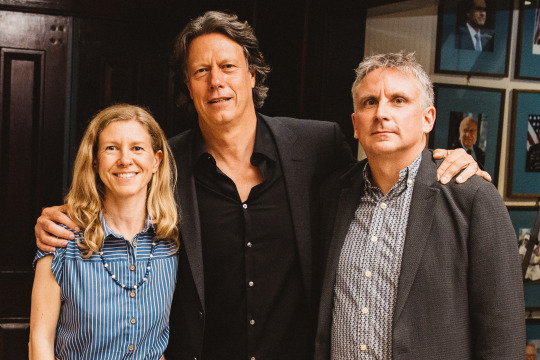
From left: former intelligence specialist Katharine Gun, director Gavin Hood and journalist Martin Bright. / Photo: Chris Ferenzi/National Press Club
What made you feel that now was the right time to tell Katharine Gun’s story? What compels this reflection on recent history? Gavin Hood: I’d like to give you an easy answer but part of it is that you struggle to get the film made—it’s been three years since we first started working on it. So, in some ways the timing felt right when I first heard about Katharine Gun, and then you think ‘oh my goodness, is the landscape going to change? Is politics going to change?’ and of course it hasn’t. If anything it feels more timely in this strange post-truth world.
It might sound odd to say that, but at the time [US president George W.] Bush and [UK prime minister Tony] Blair were spinning their lies for what they genuinely believed was some higher purpose. I think they at least would have felt a certain shame in being caught out in a lie. Certainly [former US National Security Advisor] Colin Powell did when he discovered that everything he said at the UN was a lie. He described that it was the low point of his career and he’s devastated by it and he’s apologized.
In the world that we live in now I don’t think certain politicians even care if they get caught out in a lie. What is truth? It doesn’t really matter what’s true. Say what you want to say.
What I liked about the story was the rather simple idea that truth matters, and certainly being true to my own conscience matters because what else are we in a democracy but a bunch of individuals? You have to make up your own minds and act on what you believe to be the truth.
That’s an easy thing to say but not always an easy thing to do. I like the fact that Katharine Gun was not some larger-than-life political figure, she was very ordinary in many ways. She’s quite like you and me when you meet her.
Katharine is not someone who seeks the limelight. She didn’t ever really think she’d be known around the world, and even now she tends to shy away from it. But what she had was a moment where something came across her desk at her place of work that she just felt was wrong and her conscience couldn’t live with it. That’s something that’s quite simple.
You had to build suspense from these small actions with most of the dramatic implications offscreen. How do you ensure a dialogue-driven film like this has the weight you need it to have to make its impact? The challenges you’re suggesting did give me pause. She doesn’t ever—as one studio executive said to me—“when does she ‘don her cape’ as the hero?” Are we really in this ‘don the cape’ world where every story has to be about someone saving the world or otherwise it doesn’t count? Does every person have to get to the end and succeed in overturning the evil empire? Life isn’t like that. Life is full of these small, difficult questions that cross our path. We make moral and ethical decisions of big and small kinds every day and that’s what gives us our life.
This isn’t a story about a person who changed the world, it’s a story about personal conscience and those little moments that suddenly, in her case, turned into a huge story. When it came out in The Observer newspaper, it was a big story, but what was sad about it was—and please excuse my choice of words—what trumped it 24 hours later was a bigger story.
What was that story? It was the story of us invading Baghdad. All of a sudden the news media—quite understandably from a purely commercially journalistic point of view—is not looking at how we got into the war because what do we want to see? Video footage of the bombing of Baghdad. Everyone was glued to that, and then it was about the embedded journalists with the troops and the almost Hollywood movie stories.
How we got there, the reasons for it, and whether we were lied to, took ages to come around again after they didn’t find the ‘weapons of mass destruction’ that they suggested [were] the reason they had to go in. As you know, the reason they had to come up with the ‘weapons of mass destruction’ argument was because they needed a legal reason to go in.
Under international law there are only two ways you can legally justify invading another country; one is that you have a UN resolution and we all go in together to stop a genocide—which is what they were hoping to get—but Katharine’s leak thwarted the plan because these non-permanent members refused to vote after it was discovered they’d been spied on. They never got that UN resolution which would have given them perfect cover.
They had to rely on the second legal justification for war in international law, which is self-defense and that was that they had to show that [Saddam Hussein] is a genuine threat to all of our safety. “He's so bad that he could launch chemical weapons on London in 45 minutes” was the Blair claim, and it turned out to be absolute nonsense.
The desire for a regime change and the belief that they would create a lovely, flowering democracy in the Middle East was their, I think, naïve agenda, but it allowed them to lie to us and then they got caught in the lie. Katharine is an ordinary person who’s part of the story of how those lies came about.

Keira Knightley as Katharine Gun.
Since this is recent history, you had the opportunity to talk extensively with many of the film’s subjects. What values did those discussions have that you could not get from the source book, The Spy Who Tried to Stop a War? The book mostly focused on Katharine’s journey and the politics around the time. After I read the book I asked if I could meet Katharine Gun myself, and [producer] Ged Doherty flew me to London. I spent five days with Katharine and some interesting things came up in our conversations that I hadn’t found in the book.
I did the same with Martin Bright [journalist at The Observer, portrayed by Matt Smith] who was not covered extensively in the book. I got a great deal of information from him. He referred me to the other journalists, Peter Beaumont [portrayed by Matthew Goode] and Ed Vulliamy [portrayed by Rhys Ifans], who told me a great bit about their sources, and then I went to speak to Ben Emmerson [Katharine’s lawyer, portrayed by Ralph Fiennes] and with him I got the most significant information that was not in the book.
I’ll give you two examples. First of all, he very carefully described how he came up with the defense of necessity that he used. He was going to call for these documents that he knew would show that the Attorney General Lord Goldsmith had consistently said for over a year that war without a UN resolution would be illegal under international law.
Three days before the war, Goldsmith changed his mind and came up with a bizarre idea that the 1991 Gulf War, which had been authorized by a UN resolution, had never really ended and so they could still use that. It was such a crazy fringe idea because we hadn’t won that war and the motion of that war was nonsense in the end.
I said to Ben, “How did you know when you called for those documents that you’d get what you needed? How could you be so sure that Goldsmith said what he said?” There was this pause, then he said to me, “Well you know [his Deputy Attorney General] Elizabeth Wilmshurst has resigned, right?” I did know that, but she never said why.
Well, he called Elizabeth and asked if he could come round and have a cup of tea with her. I said, “Wow, that’s never been in the press.” I ran back to Martin and told him how Ben told me the contents of the conversation that he had with her, which is depicted in the movie [Wilmshurst is portrayed by Tamsin Greig] and I asked him if he knew about this. He said, “Gavin, you’ve got a scoop!” and I replied, “Jesus, I feel like a journalist!” I’ve never made a movie where the people are still alive. I normally make up fictional people, but journalists do this every day.
The other example was that Ben told me about the conversations he had with the director of public prosecutions Lord Ken Macdonald, who’s a member of the House of Lords. If you’re in America, that’s like saying a senior senator is involved. Ben told me that they both had beach houses in Norfolk and they have known each other for many years, and Macdonald arrived unannounced at Ben’s home and started chatting to him about the case. It was very uncomfortable, and Ben said how it’s not appropriate and they can’t be talking about this.
At the coda [of the movie], Macdonald comes to Ben and says, “It wasn’t me who chose to prosecute,” and this interaction actually happened. I discovered with a bit more research that the director of public prosecutions in England has great autonomy to decide who to prosecute and who not to prosecute without any influence from any member of the government, except in cases involving the Official Secrets Act. It turns out that in order to prosecute, the director of public prosecutions must get the permission of the Attorney General.
That means Ken Macdonald must have asked Lord Goldsmith to get his permission to prosecute Katharine Gun, which was obviously given because they charged her. And then they must have said, “Lord Goldsmith, they’re asking for your documents, what do we do?” So, what we don’t know from a journalistic point of view is why did they drop that case? Our film ends with the case being dropped. Was it because Lord Goldsmith got a fright and didn’t want to show his documents?
I think it’s highly likely, because it took until 2010 when those documents were finally released to the public and showed exactly what they [had] suspected and what Wilmshurst said they would show. There’s an opportunity for a scoop here; for a journalist to go press Lord Goldsmith on this case. I think some have tried and he gives no comment. But what is the truth?
What is interesting is that although Katharine and Ben were relieved that she wasn’t going to prison, they actually felt they had a strong defense. Both of them to this day feel they never got their day in court, when they actually wanted their day in court. That is why Ben jumped up as the prosecutor was dropping the case and said, “Surely my client is entitled to know why, indeed the public is entitled to know why this case is being dropped.” He said to me he just had to get that on the record because they were shutting them down.
So this is an interesting thing, because as a piece of normal narrative filmmaking it just won’t fit into the box of ‘the hero is wronged, they go about overcoming the antagonist and set the world right’. Real life is seldom like that, and so the question became ‘is the real-life story still worth telling?’ and I think yes because the story isn’t over and we’re just a tiny part of an ongoing understanding of that war.
Martin Bright has said it’s both a film—because it’s performed by actors—but it’s also in some way a piece of journalism. I hope that we’ve discovered things that weren’t in the book, to answer your question. Maybe someone will pick up [where we left off]. I think that when it comes out in Britain, more so than America, where it’s far more personal to the British, there’s some significant questions Lord Macdonald could be approached [about] and asked why he really dropped that case.

Matthew Goode and Matt Smith in ‘Official Secrets’.
Katharine yelling at the news on TV was refreshing; a reminder of how frustrating it was in 2003. Things remain complex in world politics. What’s your advice for staying invested in politics while not getting exhausted? We are exhausted, and the danger of us being exhausted with the seemingly endless bitterness between both sides of our democracy—certainly here in America—and the flagrant disregard for truth by our current president, it’s easy to become jaded and give up. The problem with authoritarianism is that it relies on people giving up.
I grew up in apartheid South Africa in the ’70s and ’80s. I know what it’s like to watch a country get worse and worse in terms of its security legislation, especially in the ’80s with the state of emergency that literally had laws saying “you can be detained without trial indefinitely, without a right of access to a lawyer”. That’s how bad it got. It’s almost inconceivable to most people.
It’s very easy to get exhausted, stop focusing on our world, and stop voting. I think our greatest obligation is to do our little part. We don’t think it’s a big part, but if each of us plays our part that’s the only way our democracy works. The minute we’ve become exhausted, we’ve given up on the only system that works. Democracy is messy but it works in our favor as citizens. When we give up on it, we give way to tyranny. It sounds dramatic but I think it’s true.
I think we have to accept the frustration. We have to say “yes, it’s frustrating, it’s never suddenly going to be fine, it’s always going to be messy and require debate”. We have to embrace the messiness of it all and not give up and say “I have to do my job—I don’t have to be politically active every day, but I do have to be a good citizen, apply my mind to what’s out there, and vote”. That’s the only way our democracy survives.
There’s something interesting about what the Australians do in their voting system. They don’t actually say “you have to vote” but they do say every citizen has to go to the polls. Some people interpret that as everyone has to vote, but in fact you can abstain at the polls. You have to mark across the line that says “I don’t vote for anyone on this list”. At least for a moment every citizen is compelled to make a statement about what they think.
Lastly, what film made you want to be a filmmaker? I grew up very disconnected in South Africa. I never saw a TV set because there were none in the country until 1976. It was part of the government’s desire to not allow the outside world in. What I used to do with my parents was rent movies on 16mm, projected onto a sheet hanging in the living room. For me, every movie I saw was fascinating because it gave me a glimpse into the world overseas, but they were always about the people from overseas.
One day when I was about ten years old, I went to the cinema with my friend to watch a little South African movie called E’ Lollipop [also known as Forever Young, Forever Free, released in 1975], about a little white boy and a little Zulu boy who are friends. I remember being white-knuckle glued to my seat. It wasn’t because it was a thriller, it was because it was a story where people spoke with my accent and were telling a story about where I came from.
I’d never seen anything like it and it spoke to me. “Oh wow, films can be made about us— I can make a film about anything!” It doesn’t just have to be about something that people from overseas do. And I think that’s when the bug bit. I haven’t told that very often, thank you for asking.
‘Official Secrets’ is in US theaters now and plays at the London Film Festival next month.
#gavin hood#official secrets#keira knightley#iraq war#british intelligence#whistleblower#whistleblowing#leaking secrets#matthew goode#matt davis#rhys ifans#ralph fiennes#wolverine#letterboxd
0 notes
Text
Super Easy Ways To Learn Everything About BUSINESS LEADER
New Post has been published on https://personalcoachingcenter.com/super-easy-ways-to-learn-everything-about-business-leader/
Super Easy Ways To Learn Everything About BUSINESS LEADER
Are you aware of what makes a leader great?
Everyone knows some basics, but there is quite a bit to learn about it. You need to learn as much as possible and listen to others. Consider what you’re going to read and put honest effort into becoming a leader.
If you have an employee that goes above and beyond the call of duty, do not hesitate to give them extra praise and rewards. Even though it may seem like you are playing favorites, you are giving them what they deserve. Be open with other employees about it so they are aware of what rewards come with hard work.
Business is changing constantly, so be open to new ideas. Even though something has always worked well in the past, that doesn’t mean there isn’t a better way to get the job done. Be open to innovative ideas. You can try new methods on a small scale before implementing them company-wide.
Make a commitment to success. It may sound simplistic, but leadership starts with believing in the company and having a vision for its success. That vision when communicated rubs off on all that work at the company. In this way, your vision of success breeds success among your employees.
Learn to listen to your team. Giving orders is just a small part of being a leader. Learning to listen is a key to being an effective leader. Listen to your team members’ suggestions or concerns. Your team is more likely to feel respected and return the favor when you listen to what they have to say.
Make sure that you show genuine appreciation to your employees. Good performance should be acknowledged appropriately. Those leaders that look forward to the future give praise but offer much more. They may offer real rewards like bonuses, raises, promotions, and other tangible tokens of gratitude. This can motivate others to become enthusiastic about work and to stay with your company longer.
Hire people from different backgrounds to help you. All types of people can give your organization many ideas from which to draw on. Do not hire people that are exactly like you. That will sever any chances of innovation. It will also lead to failure.
Listen much more than you are motivated to talk. Being a great leader starts with listening to what your team has to say. Listen to everything your employees need to say. Here their issues and learn about the things they love. Learn from each of your workers, and hear what they’re saying about buyers and products. You’ll learn a lot just be hearing them out.
Clear communication between you and your employees is a must. Make sure your team has the information they need to complete their tasks, including the deadlines. Periodic checks are all that should be necessary to keep the project on track.
Be an honest and ethical role model for your employees. Honesty with your employees is the best way to build trust. Make sure your employees understand the ethical expectations you have for them. More than that, always behave in an ethical way yourself. If your employees observe you behaving dishonestly, they will do so as well.
As a leader, or manager, your team is your greatest asset. And, they know the business better than anyone. Try carrying a journal, or notebook with you at all times. Use it to write down any information, ideas and problems you hear from the team. Then, each week, go over your notes, and see what you can do to implement good ideas, and solve any problems you may have encountered.
Recognize the employees who consistently do a good job. Don’t focus on problems or spend too much time trying to strengthen weak employees. When the squeaky wheel always gets the grease, being a weak employee becomes motivation to get more help from the boss. Try to surround yourself with your strongest employees and help them grow.
If you must give criticism, do so constructively and in private. Every member of the staff doesn’t need to know about every mistake that is made. Being singled out in a crowd in this way is embarrassing. On the other hand, give compliments publicly. This not only build individual confidence, it lets others see that hard work is appreciated and rewarded.
Recognize employees who do well.
Publicly recognizing team members provides a much-needed boost of confidence and will also help encourage future participation and efforts. You don’t have to have a big formal award, simply acknowledging and praising your employees as part of your day can go a long way to boost morale.
With this information at your fingertips, you should be able to improve your leadership skills. Making some progress to be better at leading can really help people that work with you. There are more leaders needed in this world, so take this as an opportunity for you to show others what you have to offer. Use this new knowledge to enhance your abilities.
#achieve all your goals#become a successful business leader#best business leaders#best personal development coaching#business#business advice#business leader#business leaders#business leadership#business news#business success#business talk#business tips#executive coaching#garyvee business leaders#great business leaders#how to be a great business leader#how to become a business leader#leaders#leadership coaching#small business#strategic business leader#success mentor#successful business leaders#traits of a great business leader#what makes a great business leader#Business Coaching#Leadership Life Coaching
0 notes
Text
17 Sep 2021: Micro markets and new supermarket formats. Buy now pay later everywhere.
Hello, this is the Co-op Digital newsletter. Forward it to a pal who’d like to read about what the internet is doing to retail businesses, people, communities and society.

Micro markets and new supermarket formats
Retail research says that 50 shops a day disappear from high streets. But not all categories are struggling though: fast food takeaways had 333 stores opened in the first half of 2021, and convenience stores 332.
With downtowns staying abandoned, put tiny businesses back into residential neighborhoods - this was an interesting piece (published during the first lockdowns) on the opportunity to create new, small store formats in residential areas. More broadly, you’d expect to see many more types, sizes and formats of store and delivery services in future.
And tada! Co-op’s opened its first self serve micro market.
“Co-op has launched its first food to go offer with its new micro-supermarket proposition as consumer behaviours continue to shift.
The convenience retailer is expanding its portfolio with its first ever 24 hour self-serve, cashless micro-market at the head office for British Manufacturer and home of Henry and Hetty the Hoover, Numatic.
A total of 1000 colleagues will get access to Co-op’s own brand products such as food to go meal deals, breakfast items, milk, bread, ready meals as well drinks on the go from its ethically sourced own brand hot drinks machine, Ever Ground. [...]
Co-op micro markets can be installed across hospitals, offices, schools, gyms and train stations, to provide a specially selected range.”
The smaller, self-service format allows Co-op to serve customers in locations that aren’t suitable for traditional convenience stores.
Previously, the shop as vending machine:
“Is there a lower limit on fulfilment centre size? If they get small enough, do they look like a branch of Argos, the Post Office, or a convenience store? Or a vehicle, a cupboard or vending machine?”
“maybe you could imagine a Costco-like model: a monthly membership gets you access to the store, in which all of the goods are cheap and maybe some are free”
Food, jobs, shortages
Tesco zero-waste trial launches at 10 stores in England - shoppers can buy certain products in reusable and returnable packaging.
“The new rules mean lorry drivers importing goods will need some 700 pages of documents” - M&S warns of new food supplies threat as Brexit rules change. If the paperwork is observed, expect more food supply chain disruption.
Morrisons warns driver shortage will raise prices. Staff shortages could last two years, says industry body CBI, which wants immigration rules eased for lorry drivers, welders, butchers and bricklayers. Meanwhile, restaurants and cafes are increasing wages: Costa 5% pay rise, Itsu 11%.
Elsewhere, accountancy giant KPMG to recruit more working class staff (honestly that is the headline).
Buy now pay later everywhere
“Buy now pay later” or “installment payments” is a hugely growing sector. Some news from the biggest four providers:
Affirm announced a deal to provide installment payments to Amazon customers, and had previously signed up Shopify, which bought more than 5% of Affirm at the same time.
Payments company Square will buy Afterpay for $29 billion. (Maybe they’re paying for it in three instalments.)
Klarna now has 20 million customers in the US, and 250,000 retail partners globally.
Zip and Quadpay are merging their brands.
Elsewhere, neobank Monzo’s new pay-in-instalments service, Flex will let you retrospectively apply the instalments to transactions you’ve already made. VISA and Mastercard are making pay-in-instalment partnerships. And Tymit is a credit card that adds a buy-in-instalments feature.
Customers pay in instalments to avoid credit interest and to make purchases that don’t fit their budgets, though surely ease of use (it’s there in the shopping basket checkout) and zero friction lending decisions must also be a big factor.
You could think of BNPL like an instant loan facility made possible because the provider puts your currently “unused credit headroom” (not an official banking term!) to use to let you consume things sooner. This is the BNPL sector’s great opportunity, and its great risk. Easier credit can lead to problem debt: “a third of U.S. consumers have fallen behind on one or more payments, and 72% of those said their credit score declined”.
Another way to think about BNPL is that installment payments start to look a bit like recurring revenue.
BNPL previously in the newsletter: BNPL stacks. 42% of US shoppers had used BNPL. Affirm says it increases order value 85%.
Trains
The rail industry warns that city centres and high streets could suffer unless workers start taking the train again - perhaps there’s an assumption of a steady state in the warning, that the world can and should return to exactly the way it was before. But working patterns are already changing post-Covid.
Lumo is a new low-cost long-distance express train service trying to change the status quo on the London to Edinburgh line. Looks like they're trying to win customers from people who fly.
Various things
Ofgem plans easier way for drivers to sell energy back to grid - by using car batteries to store and later export energy to the grid, demand can be smooth and car owners earn a little money.
Live CO₂ emissions of electricity consumption - electricityMap is a live visualisation of where your electricity comes from and how much CO2 was emitted to produce it.
UK health department ends data deal with Palantir - government starting to move away from third party data platforms after openDemocracy’s legal win.
Co-op and Co-op Digital news
2021 Neighbour of the Year Awards.
The Ghosted Generation: Children as young as 10 feel permanently disadvantaged by pandemic.
Next newsletter: robots and the metaverse!
Thank you for reading
Thank you friends, readers and contributors. Please continue to send ideas, questions, corrections, improvements, etc by replying or to @rod on Twitter. If you have enjoyed reading, please tell a friend! If you want to find out more about Co-op Digital, follow us @CoopDigital on Twitter and read the Co-op Digital Blog. Previous newsletters.
0 notes
Text
WHAT IS A CORPORATE PARTY? WHAT CAN IT BE?
We have heard many times, but we have never thought about what a corporation is, what the meaning of this word is. But have we each had such an event at least once in our lives?
CONTENTS:
Why corporate parties? Types of corporate events
What is corporate culture? What is important in corporate culture? We have heard many times, but we have never thought about what a corporation is, what the meaning of this word is. But have we each had such an event at least once in our lives? Corporate is a collective event in the company, not directly related to its core business, with the direct participation of all employees.
WHY CORPORATE PARTIES? The management of any company is interested in holding mass corporate events. The main purpose of such events is to build a team, and as a result, to increase the effective activity of all employees in the organization. In fact, a corporate party is a time of relaxation among partners, but it can also bring some benefits not only to the whole team but to everyone.
The purpose of the corporate party The main goal of any corporate party is to strengthen the team, increase the level of communication and make the company feel significant for the employees. In order not to want to leave the first minute of the event, it is better to entrust all the preparation to specialists. If the company’s trusted employees deal with this issue, their task is to anticipate all the possible nuances, take into account the interests of the employees, create a certain atmosphere, otherwise the corporate party can end without even starting.
TYPES OF CORPORATE EVENTS
Work. Such corporate parties existed during the Soviet years. Government officials, schoolchildren and students were sent to social work. As a rule, they are collective farms and gardens. After very productive working communication, picnics, gatherings around the fire, songs were sung, and honest conversations were held.
Sport Competition Any competition or contest in which both participants and fans can participate. This makes the task especially easy when some people do not want to participate directly in sports, then they form a good support group. Activities can be very different, from football to checkers. And when the corporate party is over, the photos will be a great reminder of the time spent. It is possible to predict what employees are most interested in, to take these desires into account when choosing a sport.
Awards. One of my favorite prizes and gifts. The organizers have to be smart to pull the whole team with the distribution of bonuses. Ideas can range from the usual (best employee of the month) to the original (best joke). Such a corporate is a great opportunity to show employees that they are valued not only for good work.
Celebration. An official country vacation can be a good reason to have a corporate party. Everyone loves and knows how to walk. But in order not to end such a holiday with a headache, it is reasonable to start it with an entertainment program in the form of a musical or theater tour, just to end it with a music disco. And, of course, what is a corporate party without a wide range of snacks?
Trainings և Workshops: The optimal work of the team largely depends on the relationship between the employees, the work process, their personal point of view about the whole company. Training and personal growth help employees overcome the psychological barrier, teach them how to communicate with each other, managers, clients, help them get used to the already established team.
Anniversary. This is a holiday for both the founders of the company and its direct employees. During the ceremony, you should definitely count the time spent, congratulate everyone who has made a lot of investments in the development of the business, the one who has no other, have a little dream, organize a great corporate party. Practice shows that nothing brings partners to a noisy and happy party. All costs incurred by the organizers will be more than offset by the hard work of the rest of the staff.
Picnics. Another opportunity to relax the body and soul. It can be a relaxing getaway, a pleasant boat trip or a short cruise to local attractions. You can start with the official part, because what is a corporate party without the director’s words, a look to the future? Well, then, as your heart desires, from gathering around fire to sports.
Team building. In a sense, such corporate parties are reminiscent of the Soviet workforce. Teambuilding means building a team through mutual help. During physical work և exercises, employees learn to trust each other, are not afraid to ask for help են offer their services more resolutely. Teamwork makes a company a friendly family.
Presentations. A corporate event held to advertise, advertise a new product or attract customers. The direct participation of employees helps them to better understand the overall policy of the organization, to feel part of big business, to be aware of all the new ideas and achievements.
WHAT IS CORPORATE CULTURE? We understand what a corporate is, but what is a corporate culture? Communicating at work or on vacation is a culture. Question Any question including bonuses և rewards is also a cultural issue. For joint actions to bring moral and physical satisfaction, there must be a basis for them. In fact, corporate culture is a set of rules and concepts that team members must follow in their work and in any other communication.
To this end, the company’s management, together with the team, develops a number of important issues, the observance of which increases the cohesion, improves the work process, promotes the moral satisfaction of each participant in the joint production.
WHAT IS IMPORTANT IN CORPORATE CULTURE?
Mission
Horse style.
Business ethics.
Personnel policy.
Organization rituals.
Ceremonies.
Traditions:
Values:
Climate in the company.
Solving these challenges helps to differentiate the whole company from a number of similar ones և to increase the sense of unity among all members of the organization.
In general, the word “corporate” means not only a great entertainment event at the expense of the company, but also an important part of the company’s culture. Holding these parties often determines the efficiency and spirit of the team. So be careful, plan the event carefully in advance, because when the corporation is over, the photos and impressions will remain.
Courtesy:corporate party venues in lahore
0 notes
Text
Beyond Talks - Day 1
Research for, in and through practice.
Speaker 1 -
Rosie Cox & Cathy Campbell - Xero - https://www.xero.com/nz/
Design at Xero - “research won’t give you the answers, but it will point you in the right direction”.
C - Design research lead: Des majoring in Industrial at AUT, worked in research, strategy, Xero product team, in process from the beginning, customer to end product.
R - Designer: studied graphic design - branding, packaging, graphics - worked at a start-up building educational children’s apps.
Research is a part of everything that we do.
Community & social sites, design research, competitor analysis, data analytics…
Curve of uncertainty to confidence in product design, an inkling of an idea to a fully formed idea and product.
Generative: empathy research, customer research, what is the purpose? Is there a problem here? Are we solving the right problem? Absorbing information and a space of understanding.
Evaluative: are we solving the problem in the right way? Sharing paper prototypes, sharing idea, getting critique, usability at the end of it.
Observed people doing tax returns and interacting with Xero software, from doing 6 observations, they came up with insights on where they could alleviate pain or save time through improving the software. Did a design sprint with marketers, engineers and designers - consolidated down to 1 solution, tested with 6 external customers, then iterations and testing - look at data analytics and iterations cont.
Tools: generative - what / why are we finding out? Define assumptions before testing, design question framework to take you through a good conversation (to cross off points, e.g. snowball analogy), mindset of being empathetic - they are the expert, not you. E.g. “Miro” board (whiteboards/post-it notes digital, e.g. digitises real post-it notes with handwritten type, also used to capture feedback from users in different colours) — organise post-it notes, transcripts, finding commonalities in problem spaces, sharing with project team. What are the possibilities? What value will it drive?
Try e.g card sort - see if your ideas are the same, paper prototyping - scribbling away ideas / co-designing, or take them through a clickable prototype - asking unloading questions to open it up.
Usability - e.g. clickable prototype or product in production, online or in person, see interactions / where mouse is moving - feedback to the team.
Researchers are only as valuable as what they can share with their team of people. Understand what you’re working on and share it with other people.
Be comfortable with not knowing, clear about what you don’t know.
Desirability hat, but also viability and technical feasibility. Working with existing technology, many hats in the development process.
Take up research as a way to provide objectivity and rationale to your ideas.
Be curious - ask questions. Ask “why?” - why the customer needs it, why it’s important to the business, what’s the point in doing it. Why is important.
Xero Graduate Program - curious people, know about user testing, ask why, willing to learn, knowing you are part of a team, collaboration. https://www.xero.com/nz/about/careers/graduate/2021-product-design/
Data privacy, how you store information.
Optimal workshop - digital tool: card sorts, tree testing, groupings https://www.optimalworkshop.com
Team structure - “product designers” traditionally UX/UI designers. 1 accounting software, teams split across products, EGM of Design - Directors (1 area), Design Managers, team of Product Designer who work with a POD (product owner, devs, QA’s), Design Researchers (13 in total) - 75/80 people combined across team.
Developers / Engineers love data - watching user videos helps to empathise.
Ethics, legal team comes up with guidelines - do you need to collect that information, is a relevant for this project. The more data you collect, the more you need to get rid of over time. GDPR - rules around data collection.
Security, e.g. X1 (confidential, can’t leave the office) - X5 (anyone can see this)
Usability testing, depends on project and deliverables, UI has a structure around it (visually) at Xero, testing becomes more specific as prototypes change. Trying to test too much is a big pitfall, if you get clear on the top 3 things you want to find out, answer questions, define what it is you are trying to find out. Understand the point where you’re at, have you moved from UX to UI?
Test the concept, solution, value proposition first, before spending time putting detailed UI screens together.
Speaker 2 -
Alastair McCready - Inhouse - alistairmccready.com
Graphic and typeface designer - few Best awards, past AUT student
Craft of the working designer
Fonts - makes them, used to be a screen printer, using the pen tool,
“Letters are signs for sounds” - Eric Gill
Metaphors - saying something without saying it - with fonts, hinting at things or moods.
Typeface designer (makes the type, e.g. luthier guitar analogy) / typographer (someone who uses type, e.g. guitar player)
Colophon Foundry - type foundry (photo)
Commercial and bespoke range of clients.
Typographic memorials - in parks - was influential.
Research and practice
Project 1 - King’s Theatre - in Brooklyn (NY) - water damaged, got restored
Mike Meyer (sign-writer) inspired rail-lettering style but still hand drawn style. Developed it into a system - used on posters since.
Project 2 - James Bond font - Eon Productions
Looking at James Bond as a character, personality - e.g. never see him eating, he’s a solitary guy, often seen in isolation, walked the streets of London trying to get perspective.
Interpol - Guggenheim in NY - style - brutalism / modernism of architecture, bauhaus masters, imagery to pull from. ‘Babbakin’ area.
Uno Goldfinger - Architect
Set designer - Ken Adam
Napier (from here) - was smashed by an Earthquake, art deco street signs, Futura is an art deco typeface.
Typeface for James Bond, inspired by idea that it would need to look OK on a whisky bottle and on the side of a building. It’s a tool which unites elements together, e.g. watch, t-shirt both saying the same thing. Multiple weights, deck weight for subheadings.
Crests - designed to be made small - James Bond’s family crest.
Project 3 - Type as Monument - type as a memorial Trajan column in Rome.
Photographing memorials for war, NZ gave more people in WWI than other countries.
Primary research - taking a wall rubbing of plaques
“It’s about the journey, not the destination.”
Try to enjoy what you’re doing at the time.
Memorial fonts - Memorial / Flagstaff
Put it in a book, which will be published “Memorial As Type”
Scars on the landscape that unite us.
Type is a way of expressing himself, without spelling it out.
Find something that is endless to develop upon, growing research.
SO much work to be done in the type industry.
“I’m not a pilot but I could’ve been a really good pilot” - grew up around planes, his dad flies, used to hang out with the old guys who restore planes. He helped them to restore the graphics and lettering on the sides of the planes, numbers on the side of a Lancaster.
Peter Gilder - “the more reading you do, the better writer you’ll become” - it’s the same with fonts, the more you use type the more you’ll understand it. It’s a matter of caring and reading, his mentor in the UK teaches him stuff he thought he already knew. Be aware and look at other work, processes of why a font was designed for certain purposes.
Software: font lab, robo font (user can build more additions to software), glyphs (main recommendation - doesn’t crash, friendly user interface) - uses it for drawing logos.
Try to be original, but don’t be too hung up on being original. Reference 2 things, but create something new, or add on it, look backwards to see forwards.
Have confidence in your passion, get involved with DINZ, Designworks - working as an intern as he was eager and active, serving beers at a DINZ event, Anzac Tasker was there at the event, he was the only student at DINZ that night.
Passion shows through to people who give you a chance.
Is type as monument national or international - or inherent to a place - a certain tone of voice at a certain memorial - grandure or religion. Find a project where you can narrow your gaze, narrow the scope, focus on NZ heritage, ANZAC memorials, became a NZ project. Theory behind it could be international.
Achievable, local, available project.
Speaker 3 -
Felicia Irene - Culture & Theory - https://www.cultureandtheory.co.nz
Strategy Researcher - operates within a strategy team - picks key insights to deliver strategic work.
New York called, interned for Saatchi & Saatchi NY, 8 weeks, asked her to stay until her visa was up.
Passionate people doing cool work, Walmart account - world’s largest retailer at that time.
She freelanced in New Zealand, but wasn’t learning as quickly as she was in an agency.
Culture & Theory was a team of 4 (4 years ago) now they are a team of 12.
Business / Strategy / Design - started as a Designer, became a Strategist.
Compiles info about products and services for strategy team, from internal team to brand specific comms to consumer research.
Start broad, then find the essential issue - capture the issue or challenge.
Visual research - meaning or emotions.
Strategy - timeline of products or services, where numbers have grown or not. Look at issue or noise around it, e.g. Coca Cola (plastic, sustainability issue), and what are the competitors doing? What are they doing that we don’t? What is effective about it?
Research in supermarkets, whether products are standing out or not.
International landscape - outside the NZ market - find nuggets to inform argument.
Process takes a lot of curiosity, capture a lot.
Find an informed point of view, “why?” Ask the hard questions to the client and yourself, does it make a difference? Bullet-proof your argument.
The world is moving fast. Cultural trends - fall behind without knowledge of cultural trends.
Research - Hypothesise about the future* Brian Collins (strategy)
Ask what the reason is for the topic’s existence? Think of having a future beyond getting your degree. Find one thing you’re most annoyed about and find a solution for it. Or think about an area that you’re most passionate about, passion is contagious - immerse yourself in it.
All Birds, Patagonia, Blunt Umbrellas, Rhino, iPhone, Fjallraven backpacks.
The best designers think strategically, know the problem, find the solution.
“Design is a benevolent agent of change, it comes up with a thesis or an idea or premise about the future. It builds artefacts to make it real.”
Research trends, from the past year, think about what it means going forward.
Strategy and creative phase - seamless workflow
Memes - deliver on emotion or point in time - relatability to people - not a serious form of communication
Freelancing - differences between freelancing and agency: clients / small businesses with specific projects, agency project timelines are really tight, not just deliverables but it’s about the idea - the conceptual part.
Walmart “store of the future” idea at that time.
Do you have focus groups for strategy? Yes, workshops for brand (client and internal team come together) - qualitative research to test out an idea with a consumer to test potential of idea going forward.
Good things are working, bad things need to be tackled or challenged, interesting things are usually emerging.
Noise in sustainability area surrounding brands, where the world’s moving. You can’t decouple sustainability from any products or services.
Start-ups have a bigger appetite for change, but as an agency you can have a voice of change.
Portfolio advice - sometimes the prettiest tangible design work doesn’t resonate, how much passion you have is what counts as a junior and being able to articulate things / presentation. How much you are able to articulate an issue verbally, to sell an idea, convince the client and what you can do to solve it.
Meet people, talk to people, be excited.
AUT Internz program, domestic and international internships - apply to be in the pool, then later in the year apply for the particular company. e.g. Red Antler.
https://internz.aut.ac.nz
Speaker 4 -
Monique Redmond - AUT
How practice generates research
Practicing artist for 25 years, went to art school in the late 80’s went to teaching college and was a teacher for many years.
Photographic, installation and social exchange practice.
Exchange, reciprocity,
Flowers, ceramics and printed matter.
Drive-by photographs from inside the car - of flowers and flowering trees, some will have been photographed over 15 years.
Drive-by as a suburban inhabitant, became a map of her movements across space, a method.
Ceramics, in the 1970’s e.g. Public Share collective - a nod to the quintessential morning tea cup.
Collating recipes - used baking as a way to host in a social art residency. Cultural space of difference, e.g. sultanas not existing in the US.
Magnolia as an object hood in her life. Each year represents 1 flowering “A Floral Gesture” project iterations, distribution in the world - ‘take away magnolia’ printed on a folded publication.
Misprint of a magnolia photo - Index Studio print.
Characteristics of a Risograph print (as a material or process), situates it as a conceptual flower. Generosity as a material for her PHD project.
@afloralgesture - Instagram tag
Akzidenz Grotesk - Marcel Bloodthaers, e.g. Moi Aussi (1964) refused to work along the Fluxus / Dada movement at the time, he challenged it and printed over photographs.
index.org.nz
“I like to think of noticing as a conceptual act.”
The idea of what it means to keep company as a conceptual idea
The exchange event is the research focus.
Driving by is a daily practice, she mutters about flowers she notices.
An interest in publication, e.g. format of a newspaper - Flowering Now - ad in the newspaper about what is flowering in the suburbs - certain type of audience - argument about what she was announcing, she tried to explain contemporary art on the phone to the person at the Herald.
Black paper on the scanner (behind image) reduces the visual noise of the paper.
Everything begins with a story, a context. The research is the telling.
10 minute tea break, memory of having 9 minutes (excluding time to walk up and down the stairs).
Legislation around tea breaks, in 2015 the National govt took away the automatic right to take 2 x 10 min tea breaks in the working day, then the Labour govt re-introduced it.
“Public Share” art collective.
Tea break cups - glazed with colour inside.
Collective Agreement, one of the collective is a Lawyer and Installation artist.
The priority for the research is to locate the question of the idea. The idea of an artwork, an event, an exchange, a noticing.
Notions of care, empathy or love in a practice. Finding commonalities, social good, looking after one another.
Practice AS research - the idea of the document, an active archive. Practice-led research is informed by things we look at, e.g. Anna Miles (BVA)- intellectual neighbourhood or cultural neighbourhood.
Summary thoughts:
Noise around the work - Felicia / quiet research - the things I make are the things I love - Monique / notion of the idea and the uncertainty towards knowing more about a project and confidence emerging - Miro app - usability.com - Xero / scale of project - Alistair - finding the focus and making projects achievable, leave space for post-grad exploration.
0 notes
Text
10 Best Dystopian Novels of All Time
Welcome to – australiaunwrapped
Australia Unwrapped - List of all Dystopian Literature up to 2020!
Top 10 Greatest Dystopian Novels of All Time
Dystopian literature and the novels are loved by almost all the people who read books. They have got a lot of fame which author have started to bring Dystopian novel to the public. If you check the best or top selling novel than these are mostly Dystopian or Utopian (A type of Dystopian novel). Fore example the Hunger games, Game of Throne, Harry Potter and many other also. So, here is a list of top greatest dystopian novel of all time.

An Ember in the Ashes by Sabaa Tahir (2015)
Youthful Adult dream and sci-fi books have been slaughtering on the complex tragic front for a considerable length of time. Sabaa Tahir's An Ember in the Ashes, which pursues three characters in a fierce tragic culture taking after old Rome, is one of the ongoing champions. The passionate multifaceted nature in Laia, Elias and Helene's obviously various universes is shocking, and keeping in mind that their tribulations proceed all through Tahir's arrangement, the preliminaries they face in the primary volume are ethically convincing and profoundly captivating as an independent read—regardless of whether the consummation will leave you on edge for additional.

The Giver by Lois Lowry (1993)
Odds are, you originally read The Giver in school. Lois Lowry's Newbery Award-winning novel much of the time advances into study halls, and in light of current circumstances. Set in what gives off an impression of being a perfect world, the novel presents a little youngster named Jonas who lives in a torment free society. The world sudden spikes in demand for congruity and happiness—at the cost of feeling. So when Jonas is chosen to be the following Receiver of Memory and is acquainted with past privileged insights, he ends up scrutinizing his general surroundings. The Giver poses huge inquiries about what individuals are happy to forfeit so as to have a sense of security.

Red Rising by Pierce Brown (2014)
Red Rising, the main book in Pierce Brown's science fiction arrangement of a similar name, acquaints readers with an interstellar standing framework made of bad dreams. From God to the modest reds everyone is introduced to some kind of job in a public eye. At the point when Darrow finds the alarming realities behind his reality as a Red, he joins a plot to tear down the Golds' standard. Dark-coloured conveys a story that is as savage as it is spellbinding, progressively uncovering the Golds' wound manoeuvres to sustain a tragic culture.

Nineteen Eighty-Four by George Orwell (1949)
Nineteen Eighty-Four is written by the ruling writers of the 19th Century named as the Big Brother (George Orwell). The story of this novel mostly includes the barn hill in the Scottish island. In this novel he tells that he was suffered by the tuberculosis in the future (1984) which was caused by some actions of the taken by the government against Orwell. It was a masterpiece and is one of the best book you can find.

The Lathe of Heaven by Ursula K. Le Guin (1971)
The Lathe of Heaven starts in the future and take us into more terrible. Ursula K. Le Guin utilizes a forlorn hero, George Orr, to strip back the skin of the real world and question exactly how profoundly we can decide the course of our lives. Tormented by the idea that his fantasies change reality, Orr mishandles drugs, which has him consigned to important medication programs in a controlled society. Orr is unavoidably alluded to a specialist, who happens to be a renowned rest scientist with a machine that can all the more likely show Orr's fantasy control, enabling Orr to permanently modify the effectively tragic powers of history.
Snow Crash by Neal Stephenson (1992)
In Snow Crash, Neal Stephenson envisions innovation driving us forward as an element of unearthing the past, wherein keys to reshaping the future lay covered at the underlying foundations of language—think the Tower of Babel. The future of the stepson includes an anarcho-entrepreneur and they are bound together with some sort if internet 2.0, which no poor person has access to. Stephenson heaps his plot with vehicle pursues and sword battling and other high-oceans experience, however at its heart Snow Crash is an expansive investigation of class and innovation—all the more explicitly, how innovation will neglect to offer capacity to the individuals who need it most.
Oryx and Crake by Margaret Atwood (2003)
An increasingly conventional tragic world turns out in the accompanying two MaddAddam spin-offs, however, Oryx and Crake, Margaret Atwood's post-millennial contemplation on religion and science, had six years to shake around perusers' minds before the following book hit racks. That is six years of mulling over the puzzle of creation, six years of contending strict polemics, six years of bouncing uneasily at the updates on each logical advancement in the field of hereditary alteration or cloning or bioengineering. Increasingly an assessment of our genuine tragic social request than a bit of theoretical fiction, Oryx and Crake features Atwood's doubt of society's capacity to settle on humane aggregate choices.

We by Yevgeny Zamyatin (completed in 1921)
We were at first written in Russian, yet its lamentable vision of human nature under the standard of cold method of reasoning shows as full to an English-examining gathering of observers in 2018 as it was to perusers in the Soviet Union right around 100 years back. We seek after D-503, a standard withstanding man whose life is changed when he meets an enthusiastic woman—a woman who has not yet been dispensed to a Society-instructed procreative mixing.She presents a more liberated method for living that incorporates enthusiasm and an anarchic underground gathering intending to irritate the Society, however, D-503 miracles if love is a human shortcoming too erratic to be in any way left untamed. As an antique of expectation that social orders wavering on the edge of the oppressed world may figure out how to dismantle themselves back to wellbeing, We (and its skeptical closure) is a distinct disappointment.
A Scanner Darkly by Philip K. Dick (1977)
Composed as a hyper-anecdotal record of the decrease Philip K. Dick saw of the '60s and '70s medication culture in L.A., A Scanner Darkly exhibits a look at the mid-'90s were the War on Drugs left to adjust to its very own expanding illogic. Wearing tech suits that "scramble" their characters when not claiming to be low-level street pharmacists or addicts, covert officials lose grasp of what their identity is and what they should do, devoured by the life and enslavement they were obviously battling helpless before Substance D. As is generally the situation in Dick's books, Substance D misuse makes it increasingly hard for our hero, covert official Bob Arctor, to recognize which of his double lives is really the correct one.
The Hunger Games by Suzanne Collins (2008)
The tragic novel that propelled a top-rated set of three and an epic film establishment, The Hunger Games is an activity stuffed ride set in a merciless, authoritarian future. Suzanne Collins' epic carries perusers to Panem, another country established among the vestiges of North America and flaunting a well off Capitol administered by the one percent. In a savage type of populace control, the Capitol live-communicates a reality rivalry wherein youngsters battle to the passing for the excitement of the tip-top and the ghastliness of the residents consistently. Furthermore, when a 16-year-old named Katniss watches her sister get chose for the occasion, she volunteers to have her spot.
All These Things I’ve Done by Gabrielle Zevin (2011)
Gabrielle Zevin is magnificent at taking everyday psychological studies—What if a teenager who had everything got amnesia? Imagine a scenario in which passing implied living your years in reverse until you came back to the world as a child?— and transforming them into something extraordinary. In any case, her "Consider the possibility that our not so distant future world condemned chocolate and espresso?" Young Adult set of three, starting with All These Things I've Done, is a tragic champion. It shows how destroying even the most commonplace changes to a culture can be. What's more, in recounting to the story from the point of view of a resigned lady entertaining perusers with her teenager adventures, it exhibits how everything back and forth movement, even misinformed authoritarian approaches.
Visit for more information : https://www.australiaunwrapped.com/10-best-dystopian-novels-of-all-time/
1 note
·
View note
Text
Safe, happy and free: does Finland have all the answers?
In the first of our new series, The Upside, we look at how the country went from famine to topping nearly every global social ranking

Finland
The Upside
Safe, happy and free: does Finland have all the answers?
In the first of our new series, The Upside, we look at how the country went from famine to topping nearly every global social ranking
Finlands 10 great innovations
Supported by

About this content

Jon Henley in Helsinki
@jonhenley
Mon 12 Feb 2018 09.00EST Last modified on Tue 13 Feb 2018 05.28EST
Share on Facebook
Share on Twitter
Share via Email
View more sharing options
Share on LinkedIn
Share on Pinterest
Share on Google+
Share on WhatsApp
Share on Messenger
Close
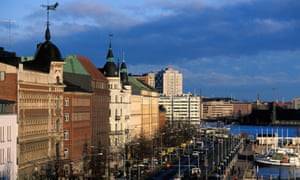
Its about cooperating. Everyone together, equally: Helsinki, the Finnish capital. Photograph: Hemis/Alamy
Western Europes last naturally caused famine ended 150 years ago this winter. In a poor and backward part of the Russian empire called Finland, more than a quarter of a million people nearly 10% of the population starved to death.
Last year, on the centenary of its independence, Finland was ranked, by assorted international indices, the most stable, the safest and the best-governed country in the world. It was also the third wealthiest, the third least corrupt, the second most socially progressive and the third most socially just.
Finlands judicial system is the most independent in the world, its police the most trusted, its banks the soundest, its companies the second most ethical, its elections the second freest, and its citizens enjoy the highest levels of personal freedom, choice and wellbeing.
The Nordic countrys 5.5 million inhabitants are also the third most gender-equal in the world and have the fifth lowest income inequality. Their babies are the least underweight, their kids feel the most secure, and their teens perform the second best at reading (only third at science, though).
In a century and a half, they seem to have done rather well. And so, as the Guardian embarks on a new series investigating the things that are going right in the world, it feels natural to start in Helsinki.
If you look at where we were then and where we are now, I think, absolutely, you can talk about a Finnish miracle, said Bengt Holmstrm, a Helsinki-born Nobel prize-winning economist not much given to exaggeration. How and why did it happen? Now thats a question.
There are limits, of course, to the usefulness of this kind of exercise: no two countries their circumstances, their histories, their people can be the same. Learnings may not be transferable. The magic sauce that made Finland would not produce the same results in, say, France.
It is true, too, that shown the long list of social and economic measures by which their country can only be judged a success, many Finns snort: emerging slowly from a long recession, with unemployment at 8% and a populist, nationalist party garnering up to 20% of the vote, the countrys not what it was, they say. Often, the response only semi-joking is, You mean other countries are worse?
Quick guide
About this series
Show Hide
What is The Upside?
News doesn’t always have to be bad indeed, the relentless focus on confrontation, disaster, antagonism and blame risks convincing the public that the world is hopeless and there is nothing we can do.
This series is an antidote, an attempt to show that there is plenty of hope, as our journalists scour the planet looking for pioneers, trailblazers, best practice, unsung heroes, ideas that work, ideas that might and innovations whose time might have come.
Readers can follow up with our Further Reading guides and can also recommend other projects, people and progress that we should report on, by filling out the form at the bottom of the article.
Was this helpful?
Thank you for your feedback.
Sign up here for a weekly email roundup from this series
But inquiring after the sauces recipe of, among others, an economist, a philosopher, a sociologist and an ex-president, intriguing ingredients emerge.
To begin with, the geography and its consequence, the climate. We live, Tarja Halonen, Finlands president from 2000 to 2012, says carefully, in a cold, harsh and remote place. Every person has to work hard for themselves. But that is not always enough. You have to help your neighbours.
Bruce Oreck, who served as Barack Obamas ambassador to Helsinki (he liked it so much he stayed), says this has been a profound, long-term influence. Its made Finns self-reliant, private, but also dependent on a highly cooperative society, where rules matter. Its cultural, but its become part of the chemistry.
Of all the Finnish words that are hard to translate into English, the one Finns cite most is sisu: a kind of dogged, courageous persistence regardless of consequence. It is what, in 1939-40, allowed an army of 350,000 men to twice fight off Soviet forces three times their number, and inflict losses five times heavier than those they sustained.

The Finnish icebreaker ship Sisu, named after the countrys term for a certain dogged stoicism. Photograph: Alamy
But there is another that is, perhaps, more revealing, says Sirpa Khknen, an award-winning historical novelist. Talkoo means working together, collectively, for a specific good, she says. Getting the harvest in, stocking wood, raising money. Its about cooperating. Everyone together, equally.
Cooperation, but also relative equality, are recurring themes. Ruled for almost 600 years by Sweden and a further century by Russia, Finland was generally and democratically poor, says Khknen. There were no serfs, but no wildly wealthy aristocrats either. Society was not hierarchical.
Since long before independence in 1917, says Riitta Jallinoja, a sociologist, gaps between the social classes in Finland have been smaller than usual. Even the industrial revolution here was modest: no Rothschilds, no Fords, not even a dynasty like Swedens Wallenbergs.
Even in todays clean, functional, visibly prosperous Helsinki, that still sort of holds. You can be walking down the street next to the richest guy in town, and you really wouldnt know, says Oreck. In Finland, insists Halonen, You dont look up at people, and you dont look down. You look level.
The countrys most successful current firm, games studio Supercell, creator of Clash of Clans, paid over 800m in tax, producing seven of Finlands top 10 income tax payers in 2016. Along with the rest of the countrys highest 10,000 or so highest earners, the amount they pay is published in an annual list, on national envy day. Finland is big on civic duty, but also on transparency.
The success of the countrys free national education system, established before independence in 1866 and regularly ranked among the worlds best, also has its roots in a more egalitarian society, says Jallinoja: Education was the key to advancement.
Not only that, says the philosopher and professor emeritus Ilkka Niiniluoto, but the whole country is actually a social construction created by university professors. The academics who led the countrys nationalist movement created Finland as a nation: its language, history, literature, music, symbols, folklore. The nationalist leader was a philosophy professor.
Since independence, nearly 30% of Finlands heads of state and government have been university professors, including half its early prime ministers. They shaped the country as we know it, says Jallinoja. But vitally, they also created confidence in social mobility, and real belief in education. That history comes with us.
If, however, Finland has been rated the worlds most literate country, it may also have something to do with a 19th-century decree that a couple could not marry in the Lutheran church before both passed a reading test. Quite an incentive, observes Halonen, to learn to read.
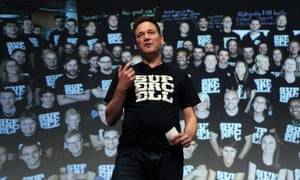
Ilkka Paananen, CEO of game developer Supercell, which paid over 800m in tax in 2016. Photograph: Bloomberg via Getty Images
Gender equality, similarly, was baked in. In 1906, Finnish women became, if not quite the first to win the vote, the first to run for electoral office. Nearly 10% of MPs in Finlands first parliament were women (the figure is now 42%); as early as 1930, up to 30% of university students were women. Women in Finland took their rights seriously, and men accepted it, says Halonen.
Other ingredients have since added to the sauce. Finland benefited enormously from wise wartime and postwar leaders, insists Holmstrm: They thought about the good of the country; took big, sensible decisions. And the consensus backed them, because everyone knew we were fighting for our existence.
Responsible choices were made, invariably by continuity-conscious coalition governments, on big industrial and infrastructure investments, that have paid dividends many times over. More recently, todays high-tech, startup-friendly Finland was born of record investment in research and development in the 1990s, nearing 4% of GDP.
Steady growth through war, the collapse of the Soviet Union and a deep recession in the 1990s, Finlands economy has expanded over the past century at a rate equalled only by Japans has bolstered trust in the nations institutions. People criticise the government constantly, and often for very good reason, says Khknen. But fundamentally, they do trust it.
As they do, on the whole, their welfare state on which Finland spends 31% of its GDP, the second highest proportion in the OECD. (If youre going to have a welfare state, says Halonen, the only real way to it is so well that theres no point having a private alternative.)
But Finns also trust each other more than most, says Andr Chaker, a Canadian-born lawyer and public speaker who has lived in the country for 25 years. Corruption and organised crime are all but nonexistent. That feeds into the business environment, he says. Things get done here faster, more reliably.
And it is trust that breeds confidence, and a willingness to innovate: the World Economic Forum ranks Finland the most innovative country, per capita, in the world. For years dominated by monolithic mining and forestry firms, then by the once-mighty Nokia, Finland today is close behind Silicon Valley in the number of startups per head.
The magic sauce, then, seems based mainly on basic virtues: self-confidence, cooperation, equality, respect for education, trust. At bottom and in practice, says Anu Partanen, a Finnish journalist who now lives in New York, it boils down to a different quality of relationship. She calls it since it is shared to a greater or lesser extent by Sweden, Norway and Denmark the Nordic theory of love.
In the family, its realising that relationships can only really flourish between individuals parents, children, spouses who are equal and independent, Partanen says. In a society, it means policy choices aimed at ensuring the greatest possible degree of independence, freedom and opportunity for everyone.
This article is part of a series on possible solutions to the worlds biggest problems. What else should we cover?
If youre having trouble using the form, click here.
Read more: https://www.theguardian.com/world/2018/feb/12/safe-happy-and-free-does-finland-have-all-the-answers
from Viral News HQ https://ift.tt/2GG0Q2e via Viral News HQ
0 notes
Photo

#TodayInHiddleHistory
Tom Hiddleston: ‘I’m fascinated by the private vulnerability of people’
The Observer. 24 January 2016.
Full article below
Tom Hiddleston and I are having an argument. It is about who followed who on Twitter first. Hiddleston is insisting I followed him. I didn’t. And for some reason, this is important to clarify. What happened, I explain, is that I woke up this morning and checked my phone and there was a notification saying you had followed me. So I thought it only polite to return the favour. And then I got hounded by several thousand Tom Hiddleston fan accounts, all of which told me how lucky I was.
He shakes his head politely.
“I just woke up and the first thing my phone told me was that you followed me,” Hiddleston says, leaning back in his chair. We are in Côte Brasserie in Hampstead, north London, just up the road from where he lives. He is wearing a grey T-shirt, the hem of each sleeve perfectly bisecting his biceps. The muscles are evident but not overwhelming. They are, like the rest of him, scrupulously amiable and unwilling to announce themselves with too much fanfare.
“This is a ridiculous conversation,” he says. “But it’s fine, by the way. I mean, you were doing your homework.”
And just like that, he wins the argument so effortlessly I almost don’t realise it’s happened. But perhaps that’s what Eton and a double first in classics from Cambridge does for you. It teaches you the ability to charm someone into submission without them noticing they’ve lost ground.
Perhaps it’s also why, in the BBC’s forthcoming six-part spy thriller The Night Manager, adapted from the eponymous John le Carré novel, Hiddleston puts in such an exceptional performance as the suave Jonathan Pine. Pine is a former soldier turned night manager of luxury hotels who goes undercover for the British intelligence services to infiltrate a criminal arms-dealing enterprise. Hiddleston stars opposite an impressive roster of British talent, including Hugh Laurie, Olivia Colman and Tom Hollander. To prepare for the role, he shadowed the night manager of the five-star Rosewood Hotel in London.
“I found the performance fascinating,” he says now. “The manager had impeccable courtesy. If somebody asks where the bar is, you say: ‘Allow me to escort you.’ It’s about making every guest feel looked after.”
I can’t imagine it was too much of a stretch. Over the next hour our conversation covers Platonic philosophy, Graham Greene and Bob Dylan. At one point I say he has a titanic brain.
“Which means it goes down,” he bats back. “There are no survivors.”
Hiddleston, 34, is solicitous company. He admits that, in preparation for this interview, he bought my first novel and is 100 pages in. But then he is known for due diligence. To prepare for his break-out film role as Loki in the 2011 Marvel Studios film Thor, he trained in the Brazilian martial art of capoeira. When he took on Coriolanus in a critically acclaimed production at the Donmar in 2014, he would listen to Holst’s The Planets to get himself in the right mood and run up and down the theatre’s fire escape before going onstage.
In I Saw the Light, which is released in March, Hiddleston stars as the American country singer Hank Williams, who died of heart failure at the age of 29. Before filming started Hiddleston embarked on a gruelling diet and exercise regime to lose the requisite weight, spent two hours a day with a dialect coach to master the Southern accent and learned to mimic Williams’s singing voice with such accuracy that he was able to perform “I’m So Lonesome I Could Cry” in front of 1,500 people at a Michigan country music festival.
Rodney Crowell, the Grammy award-winning country star who coached Hiddleston through it, commented afterwards: “I’m as respectful of the man’s work ethic as I’m mystified by his transformational skills.”
Hiddleston says he is “very” proud of the film. “I mean, that sounds arrogant. I’m just proud to be in such a…” He breaks off. “It was so far away from me; it was really not my life experience at all.”
Performing onstage in Michigan was “absolutely terrifying” but you wouldn’t know it to look at the YouTube clip. He seems calm and confident: the essence of self-possession. What happens when he gets nervous?
Hiddleston smiles. “I think I may have played the song a little fast. My inner tempo accelerates.”
That tension between the frantic inner tempo beating hard underneath an unruffled exterior is, I think, what makes him such a compelling actor. Onscreen or onstage his smoothness hints at psychopathy, an elegance that masks villainous intent.
“I suppose I’m fascinated by the private vulnerability and the exterior of people,” he says. “I think that’s an essential truth. I sort of quite like trying to find what makes people tick behind the construction of their identity.”
It seems to be working for well for him. After a childhood in London and Oxford, he was sent to boarding school at the age of seven and then went to Eton. A lot of actors these days seem to have gone to Eton, I say. Does he ever worry that…
“There are so many successful actors who didn’t go there,” he interrupts.
No, I say, they went to Harrow.
“Like Michael Fassbender and Daniel Craig and Domhnall Gleeson and Luke Evans and Gemma Arterton and Andrea Riseborough,” he continues, ignoring me. “There’s so many, the list goes on and on and on. Idris Elba.”
He says he finds the current debate about the number of middle-class actors in the profession divisive. “It’s socially divisive in a way it shouldn’t be, because I think wherever you are from you should be able to follow your passion. Wherever you went to school, if you have something authentic to contribute, you should be allowed to. There is an acknowledged problem of access and inequality of opportunity – I don’t know how to remedy that. But yeah, I’m on everyone’s side; I’m on the side of the actors. I’m not there to divide the world into pieces.”
From Eton he got a place at Pembroke College, Cambridge, before studying at Rada. He graduated in 2005 and went straight into his first film role in Unrelated, directed by Joanna Hogg, who later cast him in Archipelago. Numerous television credits followed before Thor came along. From there Hiddleston has starred in everything from Woody Allen’s Midnight in Paris to Steven Spielberg’s War Horse(he has a special affinity with soldiers and feels “a sense of responsibility and a duty to their bravery and courage”) and Guillermo del Toro’s gothic horror Crimson Peak. Later this year he takes the lead in Ben Wheatley’s hotly anticipated High-Rise, adapted from the novel by JG Ballard.
Despite his stated curiosity for understanding what makes other people tick, Hiddleston is not particularly good at turning his attention inward.
What was he like as a child? He looks down, shifts in his seat. “I think intermittently quiet and playful.”
Did that change when you went to boarding school?
“It must have done. I mean, this is not exceptional. I was very vulnerable when I first went. I went to boarding school when I was seven and then I sort of learned how to deal with it. So I must have somehow got more independent through that experience. I don’t think it was… I’ve never sort of had analysis about this or anything, so I have no idea, but… You just kind of move on. It wasn’t damaging, but I’m sure it made me independent. It must have had some…” he drifts off.
Later he’ll apologise for vagueness over the matter. He wants to be truthful, he says, but it’s “difficult, isn’t it? Sometimes it’s so hard to unpack.”
He looks up plaintively. “Am I making any sense? Am I being extremely worthy and self-regarding? I hope not.”
His parents, Diana, a former arts administrator, and James, a physical chemist, divorced when Hiddleston was a teenager. The experience was clearly painful but, he says, made him “more compassionate”. He is the middle child, with a sister either side. His younger sibling, Emma, is also an actor. The eldest, Sarah, is a journalist. Sensible woman, I say. He grins: “The most sensible.”
He has a four-year-old niece, and when he talks about her the tone lightens and he seems less anxious that I might be trying to psychoanalyse him.
“I’m called ‘Uncle Yay Monster’ because when we run, she basically wants to run as fast as me but she can’t, so after a while I just pick her up and she screams: ‘Yay!’ It’s exhausting, but enormous fun.”
And there is a lighter side to Hiddleston. I know this because if you search for “Tom Hiddleston dancing” on Google, a plethora of videos will pop up showing him busting his moves on various chat shows around the world.
Watching him, it strikes me that Hiddleston approaches his dancing with the same intense commitment he approaches his acting. There is a total immersion in the moment, even if that moment consists of doing the running man in front of a Korean chat-show host for no reason other than having been asked to do so and being too polite to say no.
“God, it’s so embarrassing,” he says. It all started a few years ago in Korea. “It was a big public Q&A, there were 7,000 people there, and I was taking questions from the audience. Somebody asked: ‘Of what body part are you most proud?’ That’s just a wrong question, to which there are only wrong answers. So I said: ‘My feet’ and they said: ‘Why?’ and I said: ‘Without my feet, I couldn’t run and I couldn’t dance.’ And they said: ‘Well, now we have to see you dance.’ So I danced… And I created a monster. There we go.”
He created a monster. But, as with everything, he did so with charm. Later I go to the loo and when I return I find he has paid the bill for our drinks and dinner without my knowing. Still, he definitely followed me first on Twitter.
The Night Manager starts on BBC1 in February
#today in hiddle history#tom hiddleston#the observer#daniel stier#photoshoot#interview#january#january 2016#2016
86 notes
·
View notes
Text
Lavie Tidhar’s groundbreaking CENTRAL STATION is relevant now
Reviews for Lavie Tidhar’s John W. Campbell Award winning CENTRAL STATION keep coming.

In ASIMOV’S SCIENCE FICTION (September/October 2017), Norman Spinrad praises the novel.
This is an unusual and groundbreaking novel, at least for me. CENTRAL STATION is that rara avis, a novel cobbled together from previously published stories that really works as a novel. CENTRAL STATION is the only novel written in English that is mostly set in a future Tel Aviv. CENTRAL STATION is also one of the best, most unusual, and convincing depictions of human-cyborg-robot-AI interactions I’ve read or heard of.
<snip>
But in CENTRAL STATION Lavie Tidhar does something congruent with form that works brilliantly in this novel be cause of the stories he is telling. The Conversation is a multi-consciousness mish-mash in the conscious perceptions of everyone, attention jumping back and forth between times and memories, and Tidhar jumps around in points of view, non-linear time packets, ongoing bits of intertwined story lines, because that is the nature of human consciousness in this fictional future.
For once the medium really is the message.
PILE BY THE BED enjoys the book.
Tidhar uses these stories to explore a number of well worn science fiction tropes – humans interconnected through a system called the Conversation, virtual reality, cyborgs created to fight global wars, sentient artificial intelligences, a robot religion (complete with robot priest), and a data vampire. But he manages to make this exploration in a humanist way and a way that is relevant now, despite the science fiction stylings. Each of his characters, despite their short time in the spotlight are interesting and so it does not matter that many of their stories do not quite resolve.
CENTRAL STATION is at times more soap opera than space opera, with the various interconnections between characters. With the exception of a military flashback it contains few of the big action or big idea set pieces of books of this type. Instead it is often quiet and contemplative, similar in that way to Becky Chambers’ recent novels. And all the better for that.

Photo: Kevin Nixon. © Future Publishing 2013
Ian Sales at IT DOESN'T HAVE TO BE RIGHT… reviews CENTRAL STATION.
CENTRAL STATION is a well-crafted piece of science fiction, with visible writing chops in evidence, and such books seem all too rare in the genre these days…
The Portuguese site RASCUNHOS lauds the tale.
With a little touch of irony about the extent of technology (which produces chatter lifts to which crew members want to escape, but can not do so until they reach their destination) CENTRAL STATION features humans who have merged with technology but still Human beings, CENTRAL STATION- with passions and fears, with disagreements and with the passing of certain ethical barriers by curiosity, but also with altruistic characters.
Slightly chaotic and gloomy in atmosphere, CENTRAL STATION is above all a human story in a distant future where the technology is extensive but does not present a glamorous glamor , rather an evolution of possibilities that seem so strange to us as to the characters that show observation and consideration.
(Translation from Portuguese courtesy of Google.)
For more info about CENTRAL STATION, visit the Tachyon page.
Cover by Sarah Anne Langton
#central station#lavie tidhar#asimov's science fiction#norman spinrad#review#pile by the bed#ian sales#it doesn't have to be right...#rascunhos#sarah anne langton#tel aviv#science fiction
0 notes
Text
Do Pass Go my BBC Radio 4 documentary, airing on Friday April 14th, has its origins in a piece I wrote about the Libyan dictator General Gadaffi playing chess on TV in the run up to his toppling, and in my bemusement about the global success of Settlers of Cataan. I had built up a big collection of old boardgames from my own youth and was intrigued by the new generation of youthful players that were spawning board gaming cafes and carving out its own terrain separate to online gaming. This post features some of the many amazing designers and players we didn’t always have time for in the final edit. Thanks to everyone who made the time to talk to us.
All photos copyright Samira Ahmed. No re-use without permission
If you’re ever wondered why the city of Essen features on so many game board maps, such as Pandemic and Ticket To Ride, that’s because it and Germany remain the heart of the boardgaming world. Producer Michael Surcombe and I started our journey in Essen at Spiel 16, where new games are launched, judged and players gather.
Vikings and terraforming Mars were the big trends, with several different competing games, such as Mars 2049. Its creator Dagnis Skurbe from Latvia, who’s been living and working in London for several years, was inspired by recent NASA missions. You realize how long some of these games are in gestation.
On the train from Dusseldorf to the Essen Messe I met Grant Dalgliesh, proprietor of the Canadian boardgames company set up by his father in 1972; one of the many small board game entrepreneurs among the giant corporate brands. He was relaunching The Last Spike, a railway building game inspired by the Robber Barons of the American railroad. The game has a focused 20 minute running time, cash and strategy and much more fun than Monopoly.
Dalgliesh observes: “The choices that a designer has to make are the hardest part. It’s easy to make a complicate game with endless rules. Less is more. That’s what I believe to be the skill.” So lots of insight into how a good game works, and the balance between ease of play and challenge to make you want to return. I notice it’s one that the teenagers I know choose to play again and again.
This slideshow requires JavaScript.
I meet groups of friends trying out great new versions of Pandemic – Legacy where the board is adapted and changes permanently. Cthulhu based on HP Lovecraft and the slower period version, Iberia – set in a 19th century pandemic where unlike in the regular version, you can’t just dispatch a medical team on a jet plane, but must build your own railroad between cities.
This slideshow requires JavaScript.
Friedemann Friese – a big name in board games – tells me how he began designing them aged 11. Power Grid is one of his many successes.
This slideshow requires JavaScript.
There are first timers in Essen too, though, some with an activist agenda. It was great to meet Jessy Bradish and a team of Northern Californian environmentalists who were still crowdsourcing funding for Climate Oasis, a climate change avoidance game. Beware the flaming tornadoes. This rather appealed to me having grown up with 60s and 70s SF dystopias like Beneath the Planet of the Apes. You can follow their progress on twitter @climateoasis.
Adult boardgames from Europe were quite a thing. Neon Limbo redemption which its Croatian designer described to me as a medieval strategy game with neon. So think Victorian steampunk mixed era. I think this involved drinking and getting a bit sexy.
There was much praise from our game experts for the multi award winning Codenames, a Czech code breaking game that seemed to draw on the challenge of the old 70s Mastermind, and had the purity of a simple idea behind the fiendish challenge of play.
This slideshow requires JavaScript.
On the shortlist for the Deutscher Spiele Prize 2016, T.I.M.E. Stories by Manuel Rozoy epitomized another big trend – for puzzle solving locked room boardgames played by a group. (A bit like the old BBC2 Adventure Game?)
The overall winner Mombasa – a German game about land grabbing in imperial Africa – has cover art focused on a white imperial hand with basket carrying natives in the background. A strangely specific Settlers of Cataan with a deeply odd lack of colonial awareness, which, I am told, is quite a thing with German games and players, where historical focus in schools has always been on the Nazis rather than earlier imperial atrocities.
This slideshow requires JavaScript.
Speaking of Nazis, what did German students make of Revenge of the Dictators, a fun game from the Netherlands based on stealing radioactive material, trying to take over the world and retiring to a desert island? This group of German friends I met were insightful, witty and thoughtful. I’m sorry our conversation didn’t make the final edit.
With Tom Vasel
I seek out Tom Vasel, mathematician, pastor and guru of The Dice Tower gaming portal, offers some spiritual enlightenment and context: He says board games have become very international. It used to be the USA v Germany. Then France, Italy, Eastern Europe. But there are more Polish publishers here. Then Japanese, Taiwan, Korea and even some from Africa.
This slideshow requires JavaScript.
He says he can usually guess where games are from as they have a certain feel. American games,observes Vassel, are usually about conflict. German games are very analystical. The French mix the two. Japan is about unusual weird things like the rabbits getting a divorce. Polish games mix everything together – war, historical, fantasy eg Cry Havoc. “It’s like Avatar. People are going to a planet mining the minerals.”
Ethics and boardgames are a strange business. They can be a fantasy escape, a bonding social ritual and a way of thinking out strategy. Autumn, a seriously good Magic the Gathering player offers a personal insight into how the world of semi professional competition has given her confidence.
James Wallace has turned his love of board games into a fascinating business at Spaaace – an agency that uses games in their business consultancy. We had the most wonderful time comparing favourite games and he talks me through why Elephant Parade – a German boardgame from 1983 – is perfection: A simple idea with endless playing satisfaction plus beautifully designed and weighted, quality wooden pieces. Don’t start me on cheap tiny pieces and boards. Wallace says you’d find Nine Men Morris boards carved into cathedrals by medieval craftsmen. It’s part of human culture.
Irving Finkel: Keeper of Cuneiform
So where else to go but back in time to the beginning of games. I seek out the British Museum’s keeper of Cuneiform Irving Finkel, who is also an expert on board games. We’ve previously discussed how the Nazis made horrific anti Semitic family board games (Juden Raus) and Vasel has pointed out how boardgames after the war were a central idea of German social rebuilding and familial reconstruction.
Finkel deciphered the rules to the Royal Game of Ur off a clay tablet; I guess you could call it the Rosetta Stone of boardgames. It’s like a much faster combination of Ludo and Backgammon; part strategy, part chase. It was to be superceded by Chess and Backgammon. It takes him a minute or so to explain it to me and we play. It is totally compelling. Sadly the British Museum no longer license and sell versions of it. I eye the few copies on his shelf enviously.
Do Pass Go is on Radio 4 on Good Friday April 14th and on iplayer after.
The making of Do Pass Go: boardgames in the internet age Do Pass Go my BBC Radio 4 documentary, airing on Friday April 14th, has its origins in a piece I wrote about the Libyan dictator General…
#boardgames#culture#essen#friedemanm friese#FTW#Germany#irving finkel#magic the gathering#pandemic#the dice tower
0 notes